
BEHIND THE SCENES: HOW WE FARMERS' MARKET
10/16/20 — Ada Broussard
Each week, we attend 12 different farmers' markets https://jbgorganic.com/markets . The closest market to our farm is the Mueller Market on Sundays, but we also make the trek to Katy each Saturday for our beloved Memorial Villages Farmers’ Market. Depending on the market, our staff usually sets their alarm clocks for 4 am, giving them enough time to get to the barn for a 5 or 5:30 am start time. Waking up early and schlepping a truck to a market is a regular ritual for many small farmers across our country who farm in rural areas and then must travel to their customers, who are clustered in urban ones.
![]() Nao, Rich, Marcela, & Jerry: Our Downtown Crew!
Nao, Rich, Marcela, & Jerry: Our Downtown Crew!
We work hard to fill our booths with mesmerizing mountains of beets and colorful carousels of carrots. These displays are more than pretty pictures, however, and we’re also creating a layout that is ergonomic for our staff and makes for a safe and pleasurable experience for our customers. We’ve been attending markets for over 15 years, and we’ve got a system down! We hope that when you visit us on Saturday or Sunday morning we make the veggie business look easy. But of course, there is an enormous amount of sweat, figuring, and planning that goes into creating a mobile and temporary produce stand. This week we are pulling back the curtain and showing you what goes into our weekend market display, a display that wouldn’t be possible without our fun-loving and talented market staff…. and the reliable functioning of their 4am alarm bells.
THURSDAY AND FRIDAY: Our Farmers Market Manager, Jerry, works on a Thursday through Monday schedule. Thursdays and Fridays Jerry spends the majority of his day hidden away in our coolers, a series of four separate rooms (and two sizeable cubbies), most of which are linked together by large and cumbersome doors and rubber curtains that make you feel like you’re entering a car wash everytime you push your way through. On Thursdays and Fridays, Jerry is charged with the enormous task of “building the market pallets”. Each market has an unofficial official parking spot in the aptly named “market cooler” and on Thursday mornings, Jerry begins by placing empty pallets in the designed areas. Over the course of two days, Jerry will build the pallets with freshly washed, sorted, and sometimes bagged produce, making sure to send a little bit of each item to every market. The quantities he’s packing aren’t random. The number of cucumbers we send to the Sunset Valley market, for example, is a finely tuned figure based off annual records, as well as the “market notes” and sales records from the previous weekend.
Even though Jerry works sometimes a 13 hour day on Saturdays, when asked he said Friday was his most challenging day at work. Head to any market JBG attends and right now you'll see bulk beets. If you love beets, you can thank Jerrry! Each market gets around 2-3 bins of beets (each weighing about 35 lbs.) and Jerry is responsible for physically packing and stacking those 1,000 lbs of beets. And those are just the figures for beets… we sometimes send upwards of 30 different items to market. We’ll save Jerry the headache of seeing the full figures, but he no doubt moves, carries, and shuffles thousands of pounds of vegetables every week, and the weekend’s smooth success depends on his dedication.
FOUR AM TO 7AM SATURDAY MORNING: Market mornings start out at our Hergotz Packing Shed (Barn) location. On Saturdays we attend 8 markets, making it the busiest market day by farm. Market drivers with the early shift arrive at the Barn at 4:30am, and those with the late shift roll in at 5:30. Once drivers arrive, they begin a synchronized dance of carts, forklifts, and pallet jackets, all happening in the dark. It’s well rehearsed, and most mornings things go smoothly. There are two main groups working alongside each other on Saturday mornings: those JBGers driving vans to market and those operating the box trucks. The drivers departing in a van work pretty independently on Saturday mornings. If there was one tragedy of the market setup, it’s that the openings in the back of our vans are too small to load vegetables with a forklift. For this reason, van drivers are responsible for hand-loading their bins of produce and market supplies, all the while muttering a prayer that they return home with a significantly emptier truck.
The drivers that operate our big box trucks, and extra long reefer truck, are responsible for managing our busiest markets (bigger markets = more vegetables = bigger trucks). These bigger vehicles will roll-top doors are loaded with a forklift, and these drives all work together on Saturday mornings, some pulling out and staging vegetables with the pallet jacket, and another loading by the light of the forklift. Somehow, our amazing market managers navigate the loading dock’s dark corners, pushing and pulling literal tons of fresh without anything going wrong, even though technically, anything could fail. Think: dead forklift, flat tires, missing CSA boxes. If all goes as smoothly, the vans are gone and the trucks are loaded by 6:30 am. The next 30 minutes, there as a buffer, are ideally spent filling water bottles, perhaps some light stretching, and chatting about the new vegetables or new protocol that will be rolled out at market. By 7:05 am, the Hergotz loading dock, once a maze of forklifts and towering pallets of vegetables, is empty, the lingering smell of freshly brewed coffee floating above the concrete.
![]() Jerry in his office on Friday morning, pulling out a pallet of CSA boxes.
Jerry in his office on Friday morning, pulling out a pallet of CSA boxes.
![]() Thankfully, the area under our barn is well lit, and collisions of carts and jacks are rare.
Thankfully, the area under our barn is well lit, and collisions of carts and jacks are rare.
![]() A driver taking a van to market must hand-load market supplies like tables, tents, and of course: vegetables.
A driver taking a van to market must hand-load market supplies like tables, tents, and of course: vegetables.
![]() Fork lift dances.
Fork lift dances.
![]() Jerry making sure every market has their merch bin, credit card machine, and hand sanitizer.
Jerry making sure every market has their merch bin, credit card machine, and hand sanitizer.
![]() Amy loading all of the market supplies onto a box truck. Tents, tables, scales, and supplies are stored together on metal farmes that we call "wunder pallets". With a forklift, all of these supplies can be loaded at once onto a box truck.
Amy loading all of the market supplies onto a box truck. Tents, tables, scales, and supplies are stored together on metal farmes that we call "wunder pallets". With a forklift, all of these supplies can be loaded at once onto a box truck.
![]() Lights, camera, action. By 7:05, all of these trucks will be long gone.
Lights, camera, action. By 7:05, all of these trucks will be long gone.
AT MARKET: Our photographer Scott followed behind as Jerry left dusty Hergotz Lane and headed a couple of miles west, to SFC’s Downtown Market. Over the past 10 years, Scott has captured thousands of moments of farm life. But even for Scott, the process of market setup was a mystery. Like any good event, no one is supposed to see the setup, correct? At each and every market we attend, our market staff is usually the first to the scene. Slowly, other vendors arrive, and empty parking lots transform into bustling markets where you can get your mushrooms, vegetables, meats, and coffee all in stop.
Like the dance that happens at the Hergotz loading dock, the actual setup of tents, tables, and displays of vegetables is a choreographed routine where muscle memory and artistic intuition manifest into an organic produce shop that would rival many grocery stores. Take a look at Scott’s photos to see each setup step.
![]() We're usually the first scene at the farmers' market. First step: open the door.
We're usually the first scene at the farmers' market. First step: open the door.
![]() Open the tents. Marvel at early morning sky reflected in the surrounding skyscrapers.
Open the tents. Marvel at early morning sky reflected in the surrounding skyscrapers.
![]() Don't forget to attach the sign before you raise the tent. That's a rookie mistake.
Don't forget to attach the sign before you raise the tent. That's a rookie mistake.
![]() Safety first: attach the tent weights before doing much else. These are home-made weights - pvc pipes with a metal foot at the bottom, clip at the top, filled with concrete.
Safety first: attach the tent weights before doing much else. These are home-made weights - pvc pipes with a metal foot at the bottom, clip at the top, filled with concrete.
![]() Unloading: One person stands in the back of the truck and deliveries all the supplies to the rim, including a cooler of water so we can stay hydrated.
Unloading: One person stands in the back of the truck and deliveries all the supplies to the rim, including a cooler of water so we can stay hydrated.
![]() Jerry builds the soon-to-be veggie displays with stacked ifcos. Marcela sets up the CSA table.
Jerry builds the soon-to-be veggie displays with stacked ifcos. Marcela sets up the CSA table.
![]() Did you know that you can schedule to pickup a CSA box at a farmer's market? Pay ahead of time, grab and go.
Did you know that you can schedule to pickup a CSA box at a farmer's market? Pay ahead of time, grab and go.
![]() Coloring in the lines.
Coloring in the lines.
![]() Some quick deliberation. SFC's Downtown market opens at 9am and the clock is ticking. There is nothing worse than not being setup as customers arrive.
Some quick deliberation. SFC's Downtown market opens at 9am and the clock is ticking. There is nothing worse than not being setup as customers arrive.
![]() Everything is off the truck, and the display is taking shape.
Everything is off the truck, and the display is taking shape.
![]() We send an average of 100 lbs. of bulk beets to each market.
We send an average of 100 lbs. of bulk beets to each market.
![]() Since March, we've modified our market display so that only JBG employees can touch vegetables. All of the day's offerings are displayed in one long line, and customers "order" what they'd like from the checkout.
Since March, we've modified our market display so that only JBG employees can touch vegetables. All of the day's offerings are displayed in one long line, and customers "order" what they'd like from the checkout.
![]() Sinage helps keep things flowing.
Sinage helps keep things flowing.
![]() Bungie cords are a particularly useful market tool.
Bungie cords are a particularly useful market tool.
![]() And just like that, there is an entire market in Downtown Austin! Time to go grab a cup of coffee before customers descend.
And just like that, there is an entire market in Downtown Austin! Time to go grab a cup of coffee before customers descend.
![]() Our first customer of the day. We are ready.
Our first customer of the day. We are ready.
WHEN IT’S ALL DONE: The average market shift is a 12 hour day, though our valiant crew that drives places like Houston and Waco often work longer hours. Generally, the length of a shift also can vary depending on the season. The more vegetables that are in season, the more bins of produce we attempt to sell, which takes longer to setup and breakdown.
After tearing down tents and consolidating bins of vegetables, the trucks are re-loaded so they can make the trek home. Jerry is often the first one back at the barn, and drivers from other markets trickle in for the next 30 minutes. It’s a jovial time at the barn - everyone is a tad delirious and is certainly pumping with a little adrenaline and lots of joy that come from meeting our customers and serving the community vegetables. There is one last cleanup dance that needs to happen before the crew can go home. Trucks are unloaded, supplies returned to their spot on the loading dock, and the leftover vegetables are brought back into the market cooler where they are sorted. You’ll usually find Jerry in the cooler cave, again, on Saturday afternoons. There, he’s finalizing the packing for Sunday markets. Half of the market staff help Jerry with this task, and the other half tackle the unglamorous and monotonous job of cleaning and sanitizing all of the empty bins that once contained the day’s offerings.
MONDAY: Each Monday, or Jerry’s “Friday”, he spends the day getting closure on the weekend. Have you ever thrown a ruckus house party involving loads of people and tons of food? If you can remember what that was like, call to mind the state of your kitchen the morning after such an event. To some degree, Jerry spends Monday cleaning up after the weekend’s wild festivities. Ideally, our market staff are returning bins of produce and supplies in a tidy manner, but sometimes a market shift can be such a busy whirlwind that beets mix with carrots, and the supply bin looks like a junk drawer. Our market staff also take detailed notes of the day's sales, which Jerry enters into a spreadsheet, and note any problems with vehicles or supplies that need restocking. Dry erase markers, rags, price signs, sign clips, credit card machines, credit card paper, table cloths, sanitizer, bungee cords, merchandise, brochures, cash registers, tables, tents, weights…. One missing or broken piece of equipment could make for a lousy market experience for our staff. Luckly, we have Jerry and Monday mornings to make it all right when the cycle begins again in a few short days.
We hope you’ve enjoyed this behind the scenes look at how we farmers’ market and we hope to see you at a market this weekend! Consider helping our market staff out and buying a few more beets than seems reasonable… the more you take home, the less we have to lug back. As always, thanks for reading!
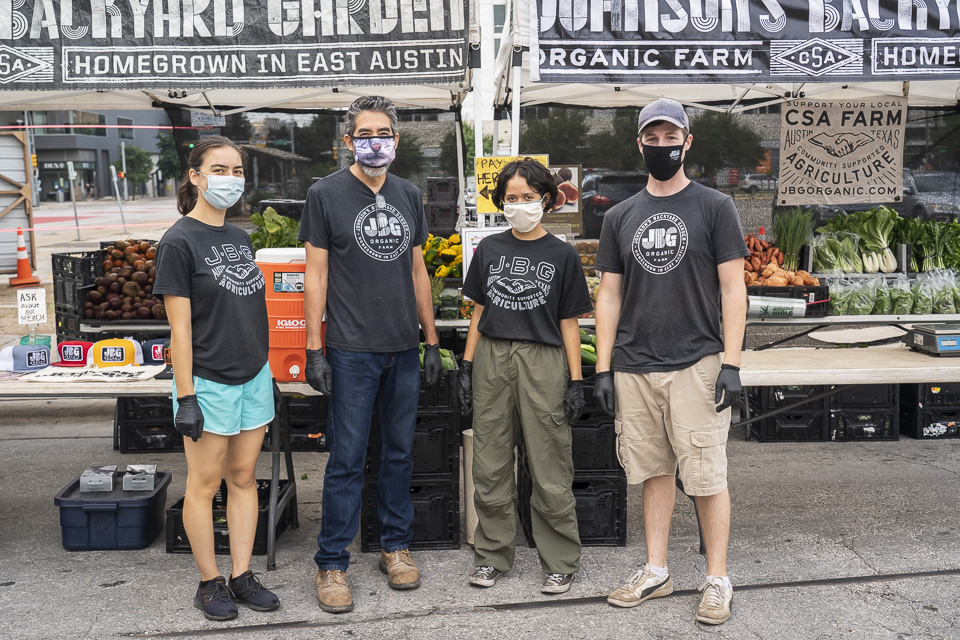 Nao, Rich, Marcela, & Jerry: Our Downtown Crew!
Nao, Rich, Marcela, & Jerry: Our Downtown Crew!
We work hard to fill our booths with mesmerizing mountains of beets and colorful carousels of carrots. These displays are more than pretty pictures, however, and we’re also creating a layout that is ergonomic for our staff and makes for a safe and pleasurable experience for our customers. We’ve been attending markets for over 15 years, and we’ve got a system down! We hope that when you visit us on Saturday or Sunday morning we make the veggie business look easy. But of course, there is an enormous amount of sweat, figuring, and planning that goes into creating a mobile and temporary produce stand. This week we are pulling back the curtain and showing you what goes into our weekend market display, a display that wouldn’t be possible without our fun-loving and talented market staff…. and the reliable functioning of their 4am alarm bells.
THURSDAY AND FRIDAY: Our Farmers Market Manager, Jerry, works on a Thursday through Monday schedule. Thursdays and Fridays Jerry spends the majority of his day hidden away in our coolers, a series of four separate rooms (and two sizeable cubbies), most of which are linked together by large and cumbersome doors and rubber curtains that make you feel like you’re entering a car wash everytime you push your way through. On Thursdays and Fridays, Jerry is charged with the enormous task of “building the market pallets”. Each market has an unofficial official parking spot in the aptly named “market cooler” and on Thursday mornings, Jerry begins by placing empty pallets in the designed areas. Over the course of two days, Jerry will build the pallets with freshly washed, sorted, and sometimes bagged produce, making sure to send a little bit of each item to every market. The quantities he’s packing aren’t random. The number of cucumbers we send to the Sunset Valley market, for example, is a finely tuned figure based off annual records, as well as the “market notes” and sales records from the previous weekend.
Even though Jerry works sometimes a 13 hour day on Saturdays, when asked he said Friday was his most challenging day at work. Head to any market JBG attends and right now you'll see bulk beets. If you love beets, you can thank Jerrry! Each market gets around 2-3 bins of beets (each weighing about 35 lbs.) and Jerry is responsible for physically packing and stacking those 1,000 lbs of beets. And those are just the figures for beets… we sometimes send upwards of 30 different items to market. We’ll save Jerry the headache of seeing the full figures, but he no doubt moves, carries, and shuffles thousands of pounds of vegetables every week, and the weekend’s smooth success depends on his dedication.
FOUR AM TO 7AM SATURDAY MORNING: Market mornings start out at our Hergotz Packing Shed (Barn) location. On Saturdays we attend 8 markets, making it the busiest market day by farm. Market drivers with the early shift arrive at the Barn at 4:30am, and those with the late shift roll in at 5:30. Once drivers arrive, they begin a synchronized dance of carts, forklifts, and pallet jackets, all happening in the dark. It’s well rehearsed, and most mornings things go smoothly. There are two main groups working alongside each other on Saturday mornings: those JBGers driving vans to market and those operating the box trucks. The drivers departing in a van work pretty independently on Saturday mornings. If there was one tragedy of the market setup, it’s that the openings in the back of our vans are too small to load vegetables with a forklift. For this reason, van drivers are responsible for hand-loading their bins of produce and market supplies, all the while muttering a prayer that they return home with a significantly emptier truck.
The drivers that operate our big box trucks, and extra long reefer truck, are responsible for managing our busiest markets (bigger markets = more vegetables = bigger trucks). These bigger vehicles will roll-top doors are loaded with a forklift, and these drives all work together on Saturday mornings, some pulling out and staging vegetables with the pallet jacket, and another loading by the light of the forklift. Somehow, our amazing market managers navigate the loading dock’s dark corners, pushing and pulling literal tons of fresh without anything going wrong, even though technically, anything could fail. Think: dead forklift, flat tires, missing CSA boxes. If all goes as smoothly, the vans are gone and the trucks are loaded by 6:30 am. The next 30 minutes, there as a buffer, are ideally spent filling water bottles, perhaps some light stretching, and chatting about the new vegetables or new protocol that will be rolled out at market. By 7:05 am, the Hergotz loading dock, once a maze of forklifts and towering pallets of vegetables, is empty, the lingering smell of freshly brewed coffee floating above the concrete.
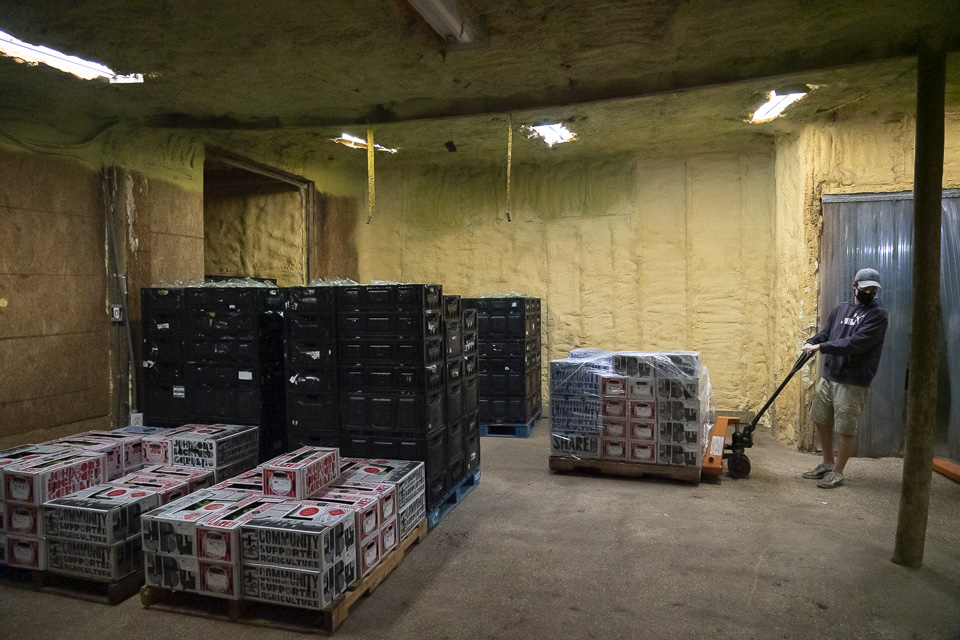 Jerry in his office on Friday morning, pulling out a pallet of CSA boxes.
Jerry in his office on Friday morning, pulling out a pallet of CSA boxes.
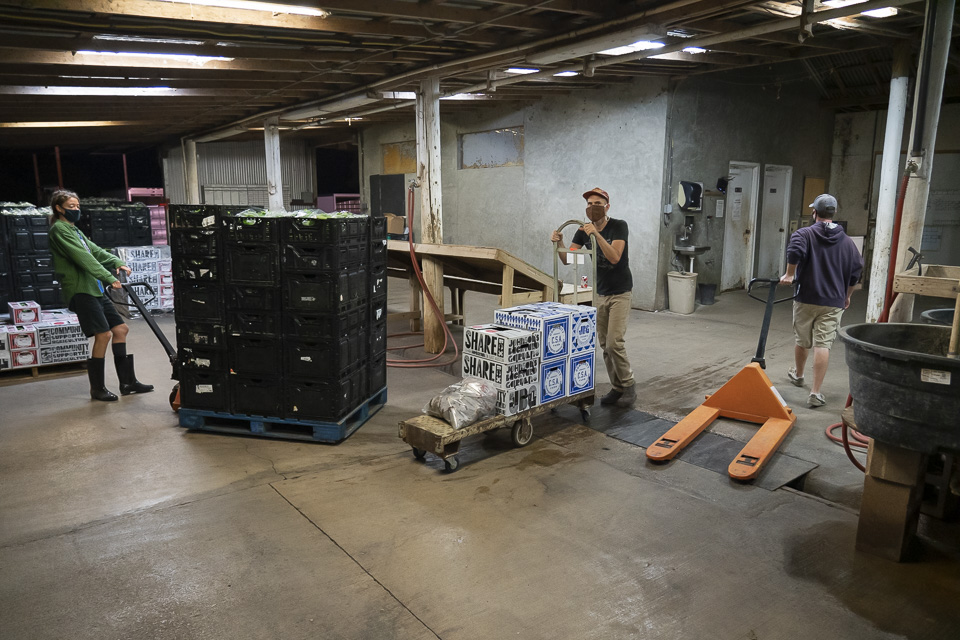 Thankfully, the area under our barn is well lit, and collisions of carts and jacks are rare.
Thankfully, the area under our barn is well lit, and collisions of carts and jacks are rare.
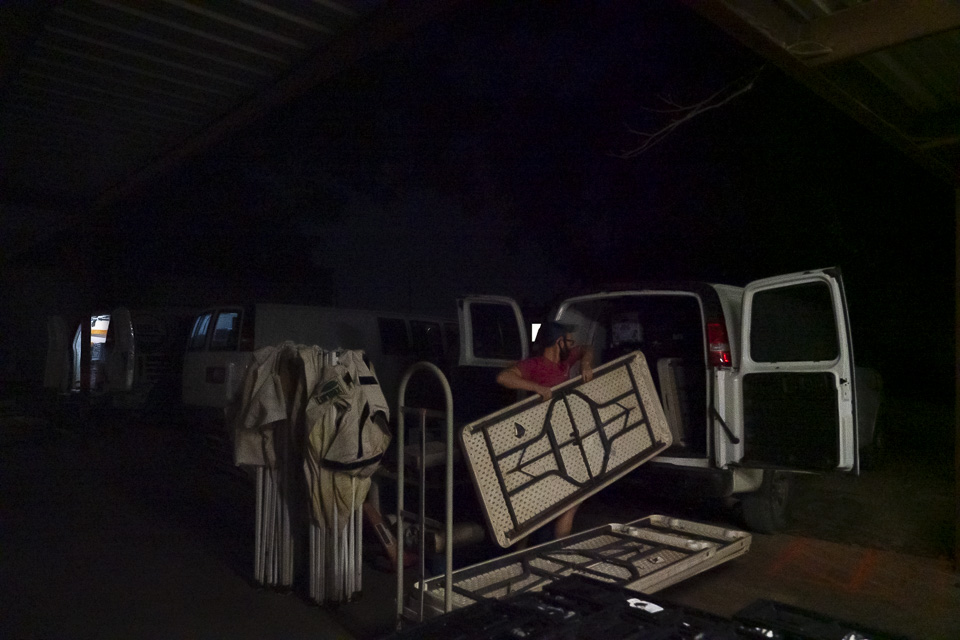 A driver taking a van to market must hand-load market supplies like tables, tents, and of course: vegetables.
A driver taking a van to market must hand-load market supplies like tables, tents, and of course: vegetables.
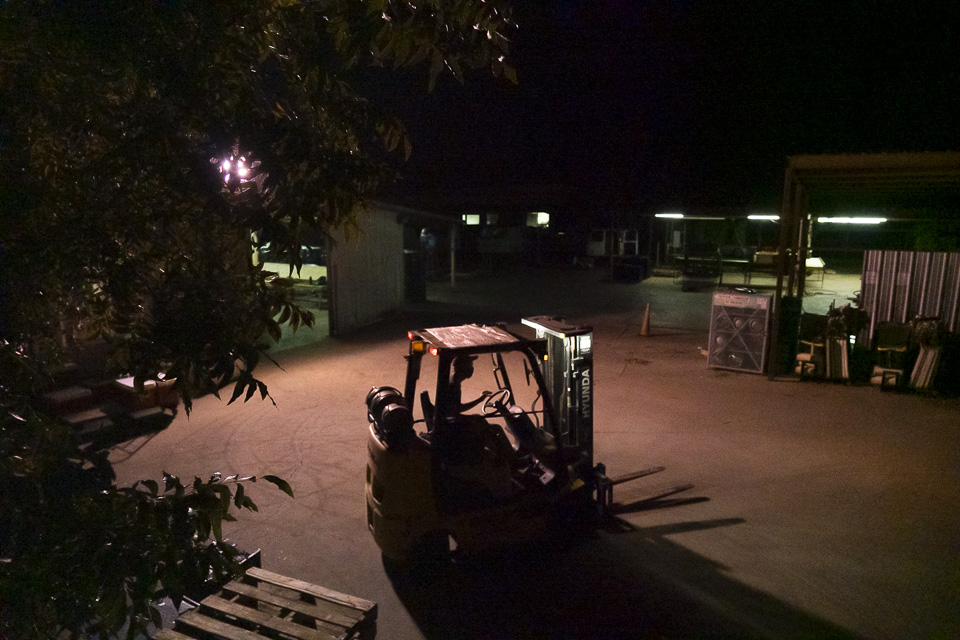 Fork lift dances.
Fork lift dances.
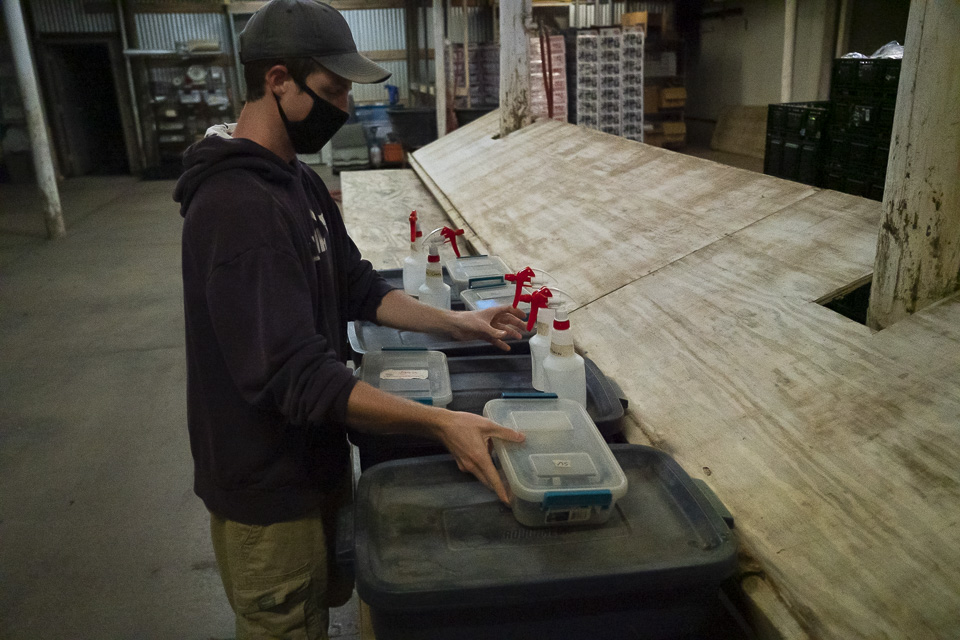 Jerry making sure every market has their merch bin, credit card machine, and hand sanitizer.
Jerry making sure every market has their merch bin, credit card machine, and hand sanitizer.
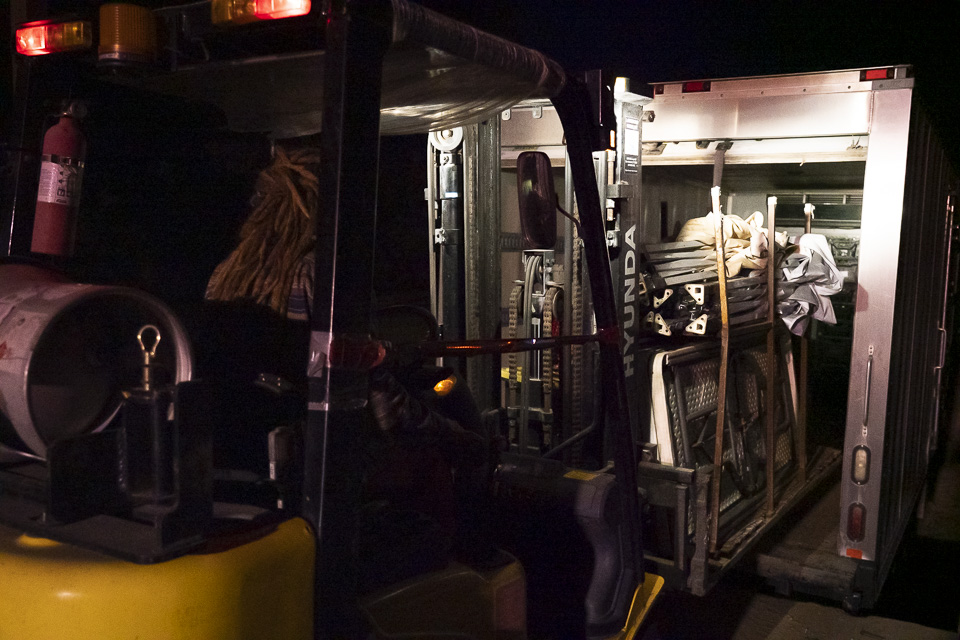 Amy loading all of the market supplies onto a box truck. Tents, tables, scales, and supplies are stored together on metal farmes that we call "wunder pallets". With a forklift, all of these supplies can be loaded at once onto a box truck.
Amy loading all of the market supplies onto a box truck. Tents, tables, scales, and supplies are stored together on metal farmes that we call "wunder pallets". With a forklift, all of these supplies can be loaded at once onto a box truck.
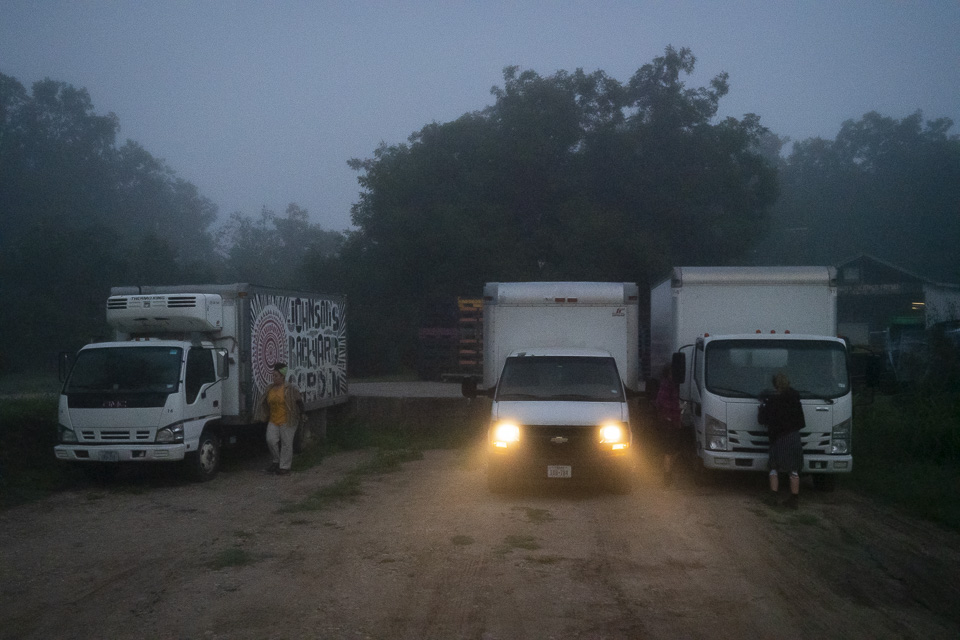 Lights, camera, action. By 7:05, all of these trucks will be long gone.
Lights, camera, action. By 7:05, all of these trucks will be long gone.
AT MARKET: Our photographer Scott followed behind as Jerry left dusty Hergotz Lane and headed a couple of miles west, to SFC’s Downtown Market. Over the past 10 years, Scott has captured thousands of moments of farm life. But even for Scott, the process of market setup was a mystery. Like any good event, no one is supposed to see the setup, correct? At each and every market we attend, our market staff is usually the first to the scene. Slowly, other vendors arrive, and empty parking lots transform into bustling markets where you can get your mushrooms, vegetables, meats, and coffee all in stop.
Like the dance that happens at the Hergotz loading dock, the actual setup of tents, tables, and displays of vegetables is a choreographed routine where muscle memory and artistic intuition manifest into an organic produce shop that would rival many grocery stores. Take a look at Scott’s photos to see each setup step.
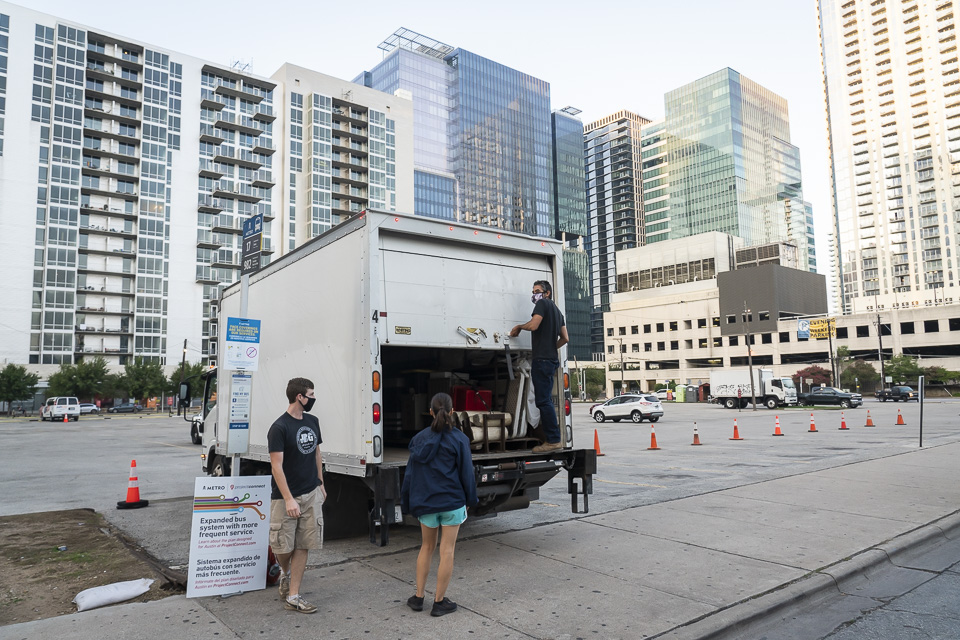 We're usually the first scene at the farmers' market. First step: open the door.
We're usually the first scene at the farmers' market. First step: open the door.
 Open the tents. Marvel at early morning sky reflected in the surrounding skyscrapers.
Open the tents. Marvel at early morning sky reflected in the surrounding skyscrapers.
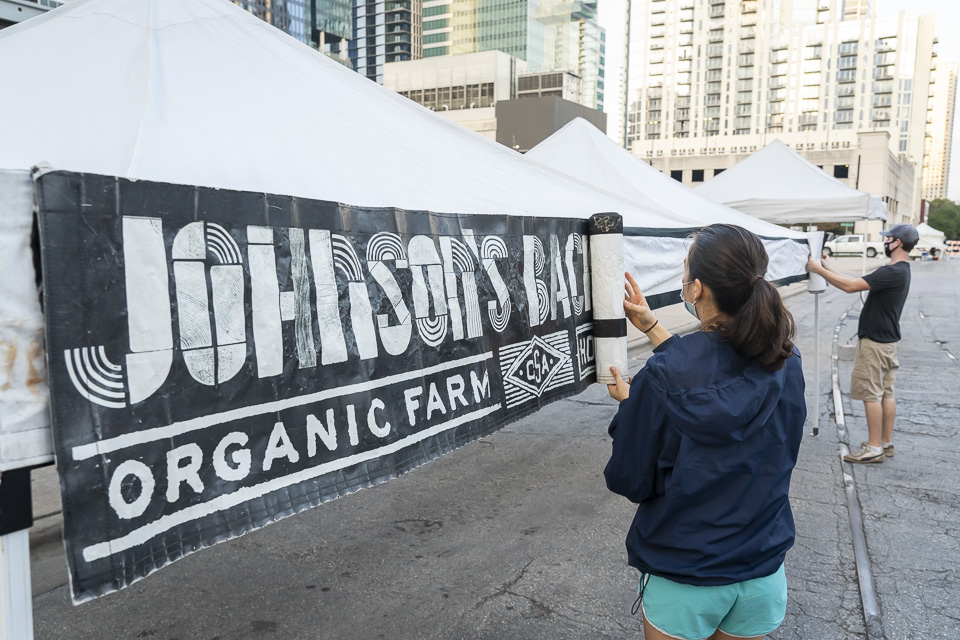 Don't forget to attach the sign before you raise the tent. That's a rookie mistake.
Don't forget to attach the sign before you raise the tent. That's a rookie mistake.
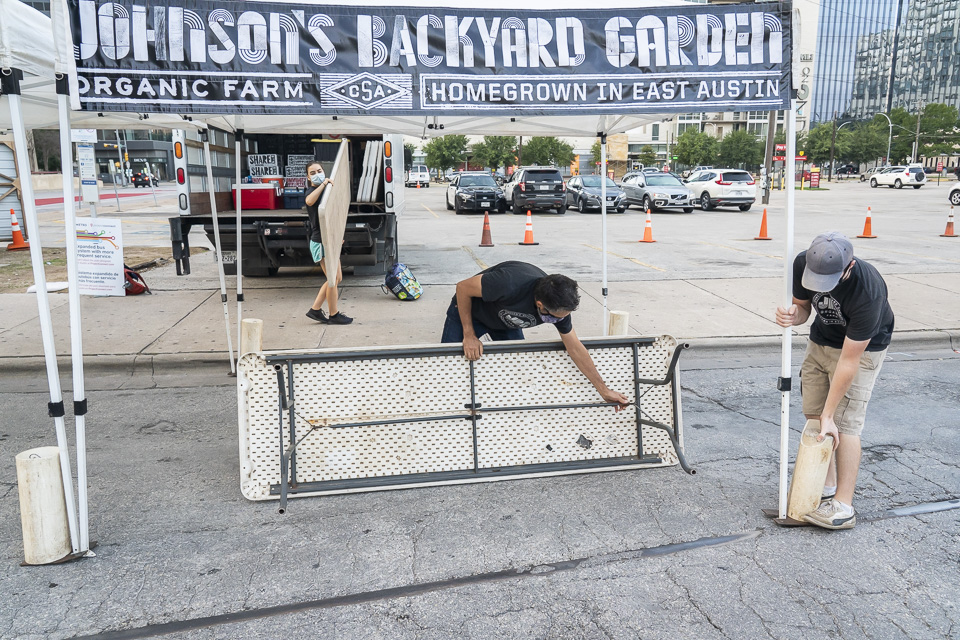 Safety first: attach the tent weights before doing much else. These are home-made weights - pvc pipes with a metal foot at the bottom, clip at the top, filled with concrete.
Safety first: attach the tent weights before doing much else. These are home-made weights - pvc pipes with a metal foot at the bottom, clip at the top, filled with concrete.
 Unloading: One person stands in the back of the truck and deliveries all the supplies to the rim, including a cooler of water so we can stay hydrated.
Unloading: One person stands in the back of the truck and deliveries all the supplies to the rim, including a cooler of water so we can stay hydrated.
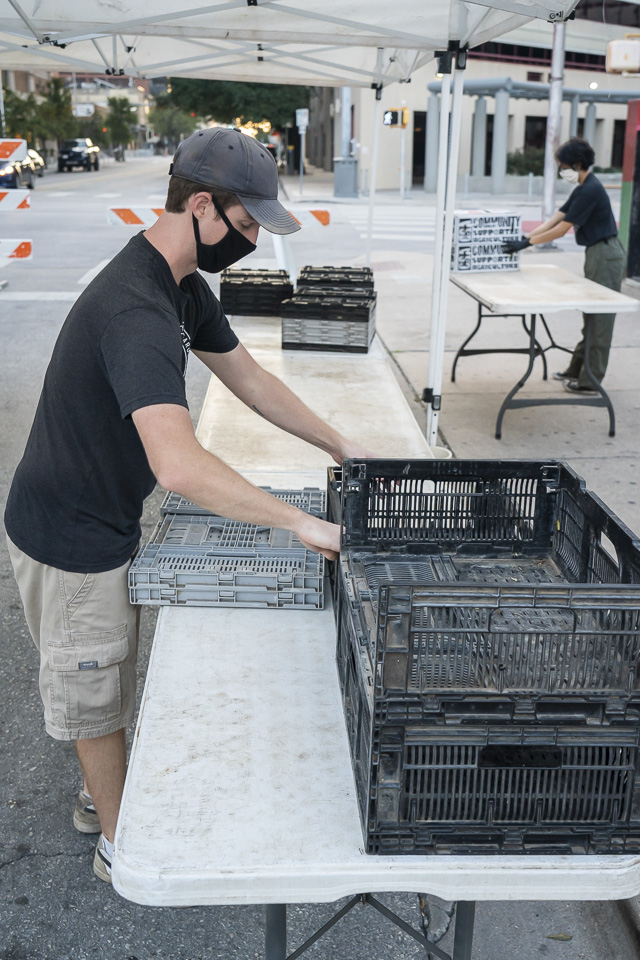 Jerry builds the soon-to-be veggie displays with stacked ifcos. Marcela sets up the CSA table.
Jerry builds the soon-to-be veggie displays with stacked ifcos. Marcela sets up the CSA table.
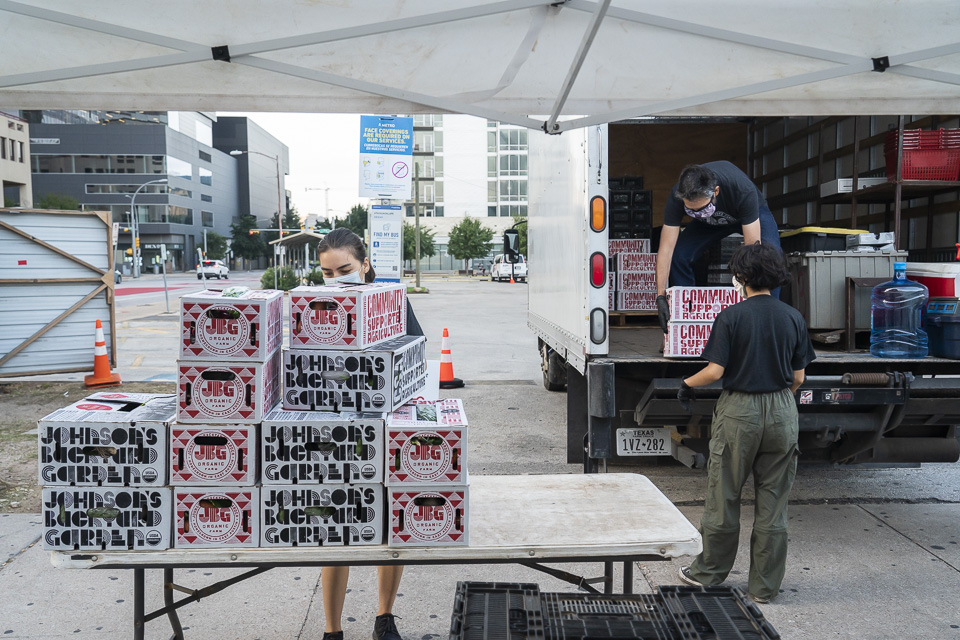 Did you know that you can schedule to pickup a CSA box at a farmer's market? Pay ahead of time, grab and go.
Did you know that you can schedule to pickup a CSA box at a farmer's market? Pay ahead of time, grab and go.
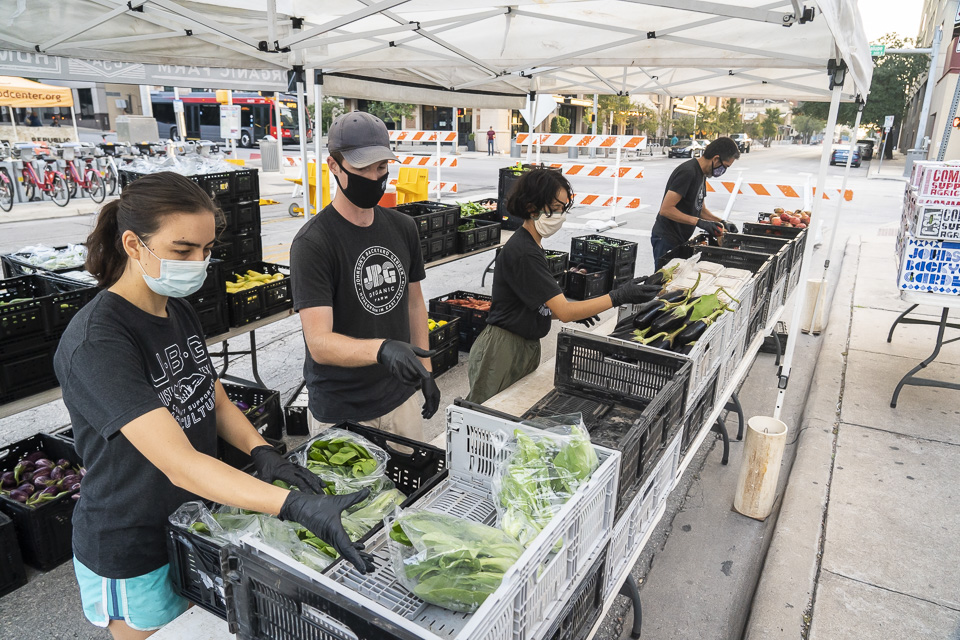 Coloring in the lines.
Coloring in the lines.
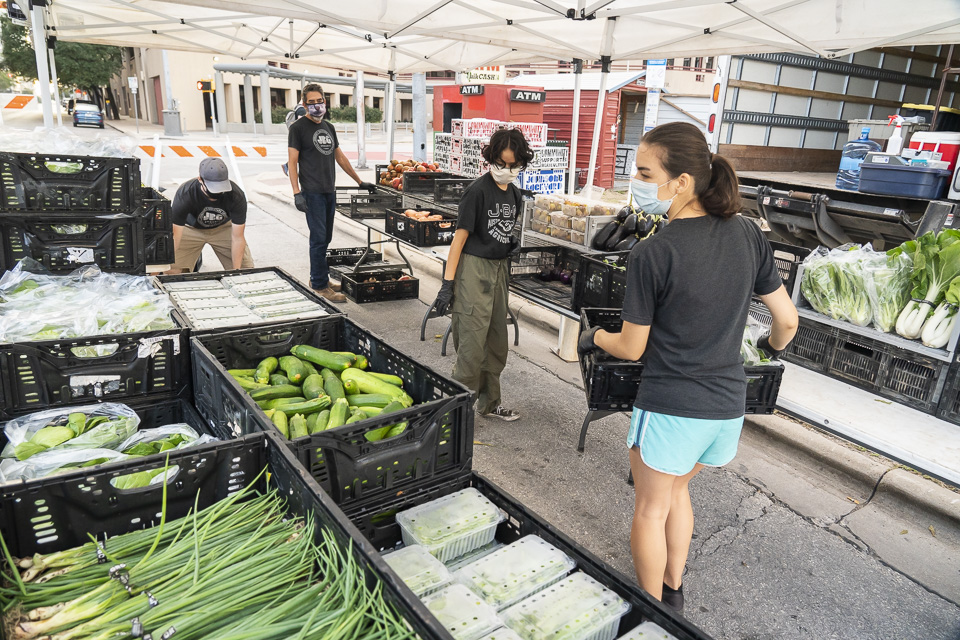 Some quick deliberation. SFC's Downtown market opens at 9am and the clock is ticking. There is nothing worse than not being setup as customers arrive.
Some quick deliberation. SFC's Downtown market opens at 9am and the clock is ticking. There is nothing worse than not being setup as customers arrive.
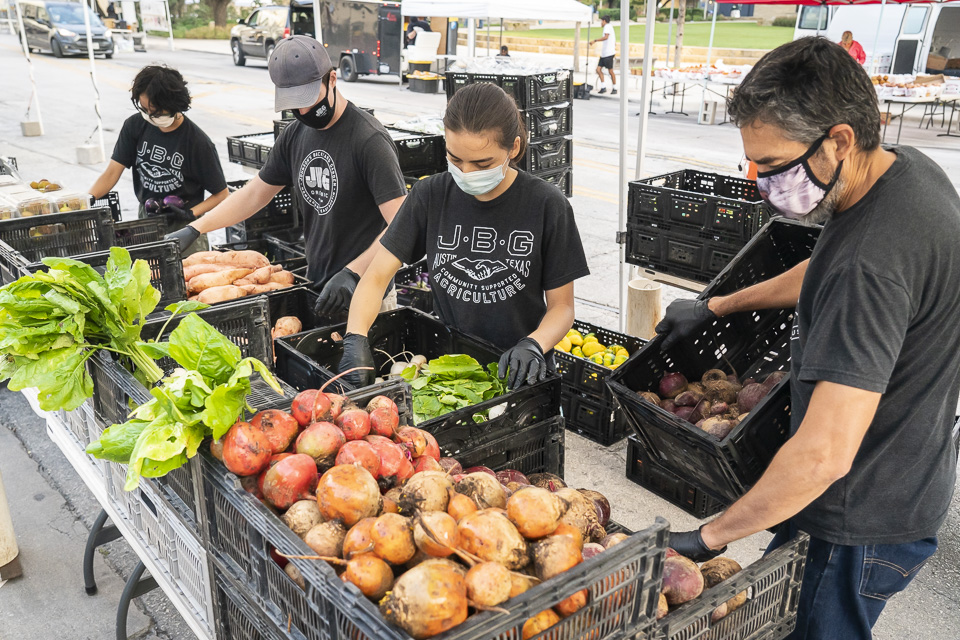 Everything is off the truck, and the display is taking shape.
Everything is off the truck, and the display is taking shape.
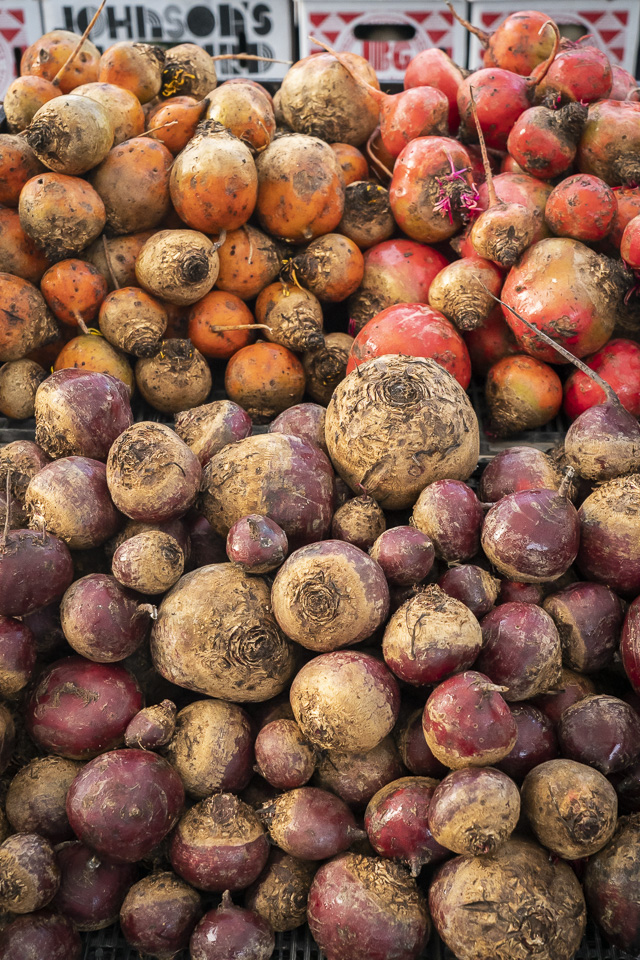 We send an average of 100 lbs. of bulk beets to each market.
We send an average of 100 lbs. of bulk beets to each market.
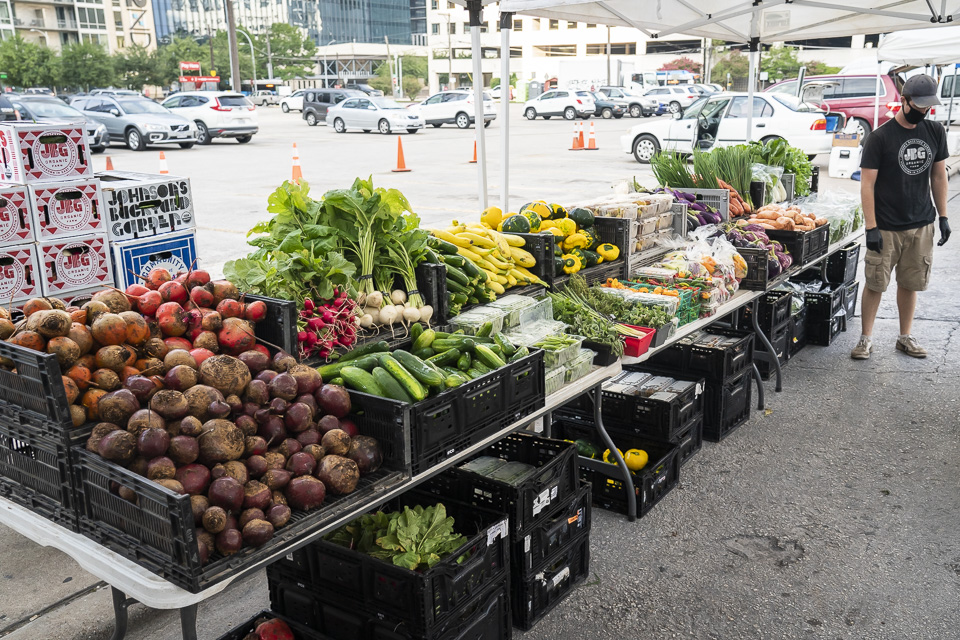 Since March, we've modified our market display so that only JBG employees can touch vegetables. All of the day's offerings are displayed in one long line, and customers "order" what they'd like from the checkout.
Since March, we've modified our market display so that only JBG employees can touch vegetables. All of the day's offerings are displayed in one long line, and customers "order" what they'd like from the checkout.
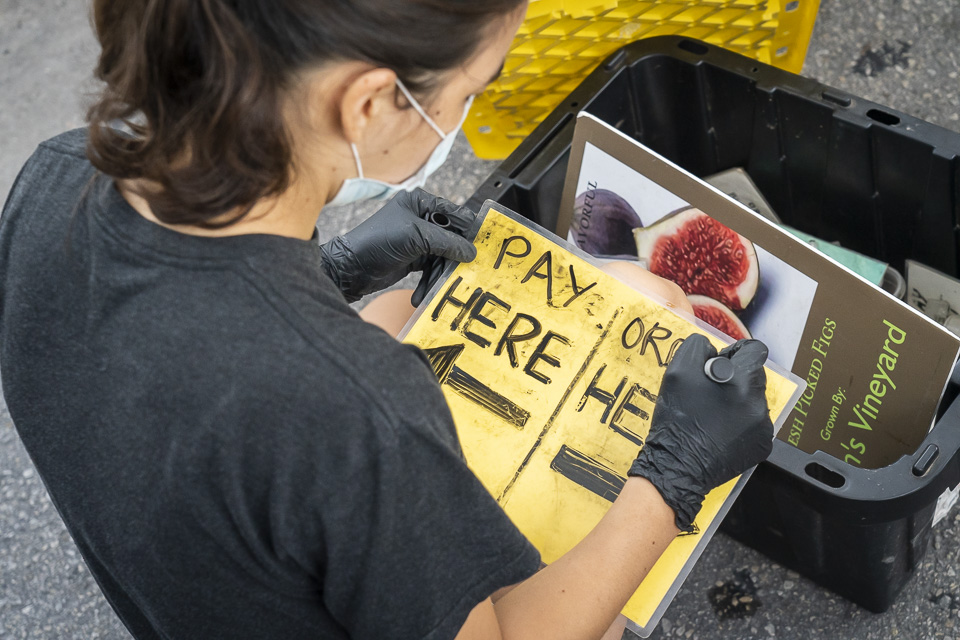 Sinage helps keep things flowing.
Sinage helps keep things flowing.
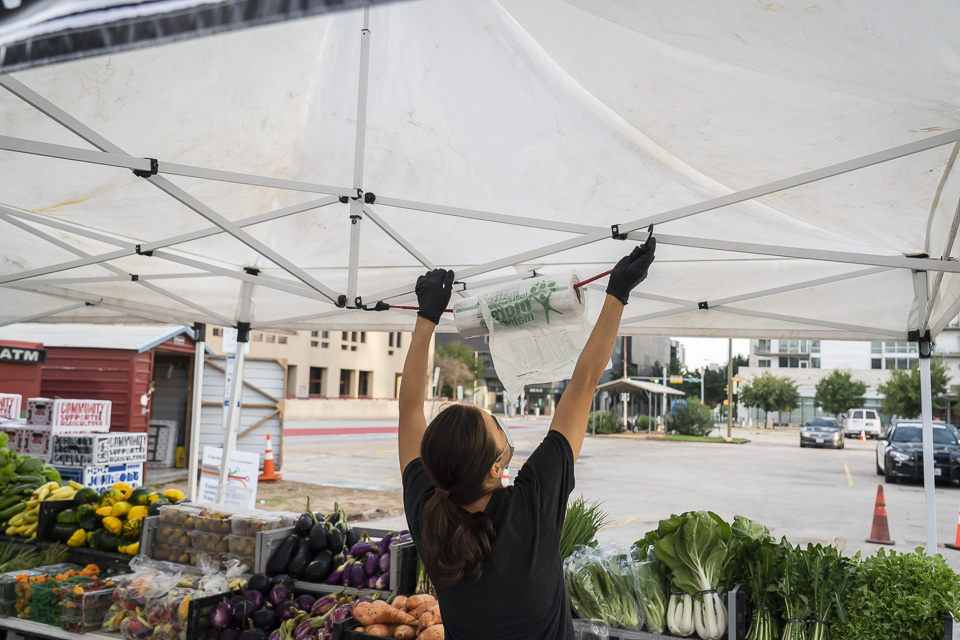 Bungie cords are a particularly useful market tool.
Bungie cords are a particularly useful market tool.
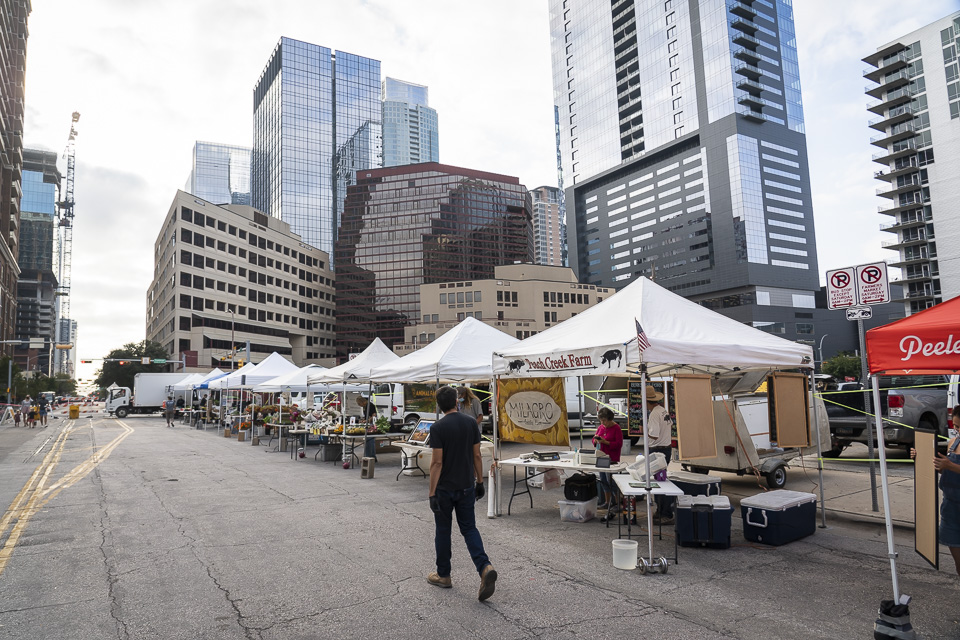 And just like that, there is an entire market in Downtown Austin! Time to go grab a cup of coffee before customers descend.
And just like that, there is an entire market in Downtown Austin! Time to go grab a cup of coffee before customers descend.
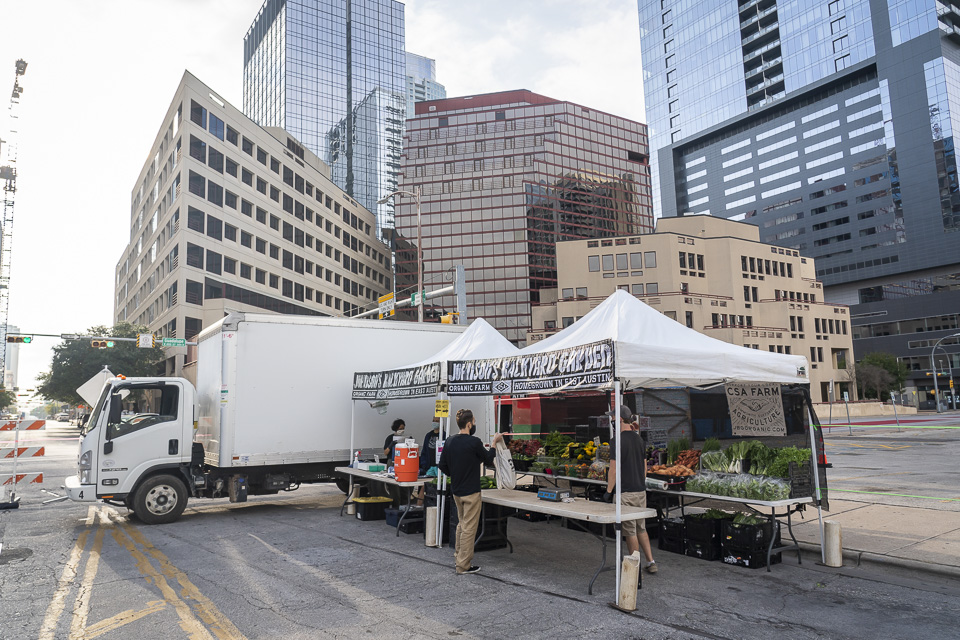 Our first customer of the day. We are ready.
Our first customer of the day. We are ready.
WHEN IT’S ALL DONE: The average market shift is a 12 hour day, though our valiant crew that drives places like Houston and Waco often work longer hours. Generally, the length of a shift also can vary depending on the season. The more vegetables that are in season, the more bins of produce we attempt to sell, which takes longer to setup and breakdown.
After tearing down tents and consolidating bins of vegetables, the trucks are re-loaded so they can make the trek home. Jerry is often the first one back at the barn, and drivers from other markets trickle in for the next 30 minutes. It’s a jovial time at the barn - everyone is a tad delirious and is certainly pumping with a little adrenaline and lots of joy that come from meeting our customers and serving the community vegetables. There is one last cleanup dance that needs to happen before the crew can go home. Trucks are unloaded, supplies returned to their spot on the loading dock, and the leftover vegetables are brought back into the market cooler where they are sorted. You’ll usually find Jerry in the cooler cave, again, on Saturday afternoons. There, he’s finalizing the packing for Sunday markets. Half of the market staff help Jerry with this task, and the other half tackle the unglamorous and monotonous job of cleaning and sanitizing all of the empty bins that once contained the day’s offerings.
MONDAY: Each Monday, or Jerry’s “Friday”, he spends the day getting closure on the weekend. Have you ever thrown a ruckus house party involving loads of people and tons of food? If you can remember what that was like, call to mind the state of your kitchen the morning after such an event. To some degree, Jerry spends Monday cleaning up after the weekend’s wild festivities. Ideally, our market staff are returning bins of produce and supplies in a tidy manner, but sometimes a market shift can be such a busy whirlwind that beets mix with carrots, and the supply bin looks like a junk drawer. Our market staff also take detailed notes of the day's sales, which Jerry enters into a spreadsheet, and note any problems with vehicles or supplies that need restocking. Dry erase markers, rags, price signs, sign clips, credit card machines, credit card paper, table cloths, sanitizer, bungee cords, merchandise, brochures, cash registers, tables, tents, weights…. One missing or broken piece of equipment could make for a lousy market experience for our staff. Luckly, we have Jerry and Monday mornings to make it all right when the cycle begins again in a few short days.
We hope you’ve enjoyed this behind the scenes look at how we farmers’ market and we hope to see you at a market this weekend! Consider helping our market staff out and buying a few more beets than seems reasonable… the more you take home, the less we have to lug back. As always, thanks for reading!
HORSERADISH AND BEET YOGURT DIP
10/16/20 — Ada Broussard

Recipe and swirly photos by Mackenzie Smith Kelley.
Last week, Jesse Szewczyk posted a gorgeous picture of spicy yogurt beet dip on Instagram, and I knew right away that some version of this would become a staple in our house. Beets are roasted whole, then blended with lemon juice, horseradish & salt, swirled into a mixture of salted yogurt and sour cream, then drizzled with olive oil, fresh dill and chives and a few cracks of black pepper.
Jesse’s dip is beautiful as it is delicious, and while his recipe makes enough for a full party, we had no problem polishing it off between the three of us in a few days (hello, electric sandwich spread). The ratio of yogurt to sour cream can be adjusted based on what you have on hand, and I would encourage you to push the limits with the horseradish, starting at ¼ a cup and increasing up to ½ cup until you can feel it in your nose. (This recipe is for people who love horseradish.)
Oh! Happy voting season! Here’s a link to early polling information in Travis County. Have you made your voting plan?
Recipe adapted from Jesse Szewczyk
½ pound fresh beets
¼-½ cup freshly grated horseradish (jarred is fine, too)
2 teaspoons raw honey
1 ½ teaspoon kosher salt, more to taste
A few turns of black pepper
Juice from 2 medium lemons
Zest from 1 lemon
2 cups plain, full-fat yogurt
1 cup sour cream
1 teaspoon salt, more to taste
Freshly chopped dill & chives for garnish
Olive oil to drizzle
Salt & pepper to taste
- Preheat the oven to 400°F. Wash the beets, but do not dry, and wrap them individually in aluminum foil. Place the wrapped beets on a rimmed baking sheet and roast until fork-tender, 65 to 75 minutes. Remove from the oven and let cool at room temperature for 30 minutes.
- While the beets are cooling, combine horseradish, lemon juice, honey, salt, pepper, and the juice of 2 medium lemons in the bowl of a food processor.
- Once the beets are cooled, rub them with a paper towel to remove their skins and cut them into 1-inch pieces. Add to the bowl of the food processor with the horseradish mixture and blend until completely smooth, adding 1 tablespoon of water to thin the mixture out if needed. Add more horseradish to taste.
- Thoroughly combine Greek yogurt and sour cream in a large serving bowl and stir in a teaspoon of salt. Add the beet mixture and gently fold it in to create streaks of pink. (Do not overmix.) Taste and season with additional salt and pepper if needed. Garnish with chives, dill, a drizzle of olive oil, and a few big cracks of black pepper. Serve immediately with assorted raw vegetables and crackers for dipping.
 Photo by Mackenzie Smith Kelley
Photo by Mackenzie Smith KelleyPHOTOS FROM THE FARM: 10.16.20
10/13/20 — Ada Broussard
Every Friday afternoon, we finalize the CSA box contents for the following week. (This is why you can customize your box starting on Saturday morning!). On Tuesday afternoons, once the first of the CSA box contents have been harvested, our photographer Scott goes to our Hergotz location and snaps a photo of the weekly box contents which we post on our website and social media. This past Tuesday, Scott captured the excitement of the day: volunteers helping Lyndsie paint one of our new delivery vehicles. Faceless white van, no more!
![]() You'll never finish if you don't start. Photo by Scott David Gordon.
You'll never finish if you don't start. Photo by Scott David Gordon.
![]()
![]() Long-time JBG team member Lyndsie is heading up this paint project. She may be masked, but we'd recognize that side pony anywhere. Photo by Scott David Gordon.
Long-time JBG team member Lyndsie is heading up this paint project. She may be masked, but we'd recognize that side pony anywhere. Photo by Scott David Gordon.
![]() Lyndsie used transparencies and an old-school projector to trace the designs onto our vans. Photo by Scott David Gordon.
Lyndsie used transparencies and an old-school projector to trace the designs onto our vans. Photo by Scott David Gordon.
![]() You gotta start somewhere. Photo by Scott David Gordon.
You gotta start somewhere. Photo by Scott David Gordon.
![]() We're so grateful to our volunteers that lent a steady hand to this project! Photo by Scott David Gordon.
We're so grateful to our volunteers that lent a steady hand to this project! Photo by Scott David Gordon.
![]() Cinder block seats and a bluebird sky. What more could you want in a day? Photo by Scott David Gordon.
Cinder block seats and a bluebird sky. What more could you want in a day? Photo by Scott David Gordon.
![]() As you may know, we've put a pause on our volunteer program for the past 6 months. We've made an exception for this special project, and it feels wonderful to welcome so new faces to the farm. Photo by Scott David Gordon.
As you may know, we've put a pause on our volunteer program for the past 6 months. We've made an exception for this special project, and it feels wonderful to welcome so new faces to the farm. Photo by Scott David Gordon.
![]() Homegrown in East Austin circles the letters JBG, made up with blocks and lines just like the layout of the farm fields. Photo by Scott David Gordon.
Homegrown in East Austin circles the letters JBG, made up with blocks and lines just like the layout of the farm fields. Photo by Scott David Gordon.
![]() We love the transformation from a boring white van to a branded veggie mobile, bright with color and ripe with potential! Photo by Scott David Gordon.
We love the transformation from a boring white van to a branded veggie mobile, bright with color and ripe with potential! Photo by Scott David Gordon.
![]() Even though our veggies are now technically grown at the farm, they started off as homegrown offerings from Brenton's backyard on Holly Street. Photo by Scott David Gordon.
Even though our veggies are now technically grown at the farm, they started off as homegrown offerings from Brenton's backyard on Holly Street. Photo by Scott David Gordon.
![]() The pinkies are how you know they're professionals. Photo by Scott David Gordon.
The pinkies are how you know they're professionals. Photo by Scott David Gordon.
![]() Farmers are artists, too! Photo by Scott David Gordon.
Farmers are artists, too! Photo by Scott David Gordon.
![]() Lots of concentration, and some fun too :) Photo by Scott David Gordon.
Lots of concentration, and some fun too :) Photo by Scott David Gordon.
![]() These are professionals, y'all!
These are professionals, y'all!
![]() High, medium, low. Photo by Scott David Gordon.
High, medium, low. Photo by Scott David Gordon.
![]() Thanks again to the wonderful women who helped paint our new delivery truck!! Photo by Scott David Gordon.
Thanks again to the wonderful women who helped paint our new delivery truck!! Photo by Scott David Gordon.
Do you have studio art or painting experience? Does this volunteer opportunity sound like something you'd like to do? Email Ada (ada@jbgorganic.com) with PAINT in the subject line to get notified when we schedule our next paint day. Please makes sure to mention your artistic experience. All volunteers are thanked with a box of veggies and the satisfaction of knowing you beautified a van.
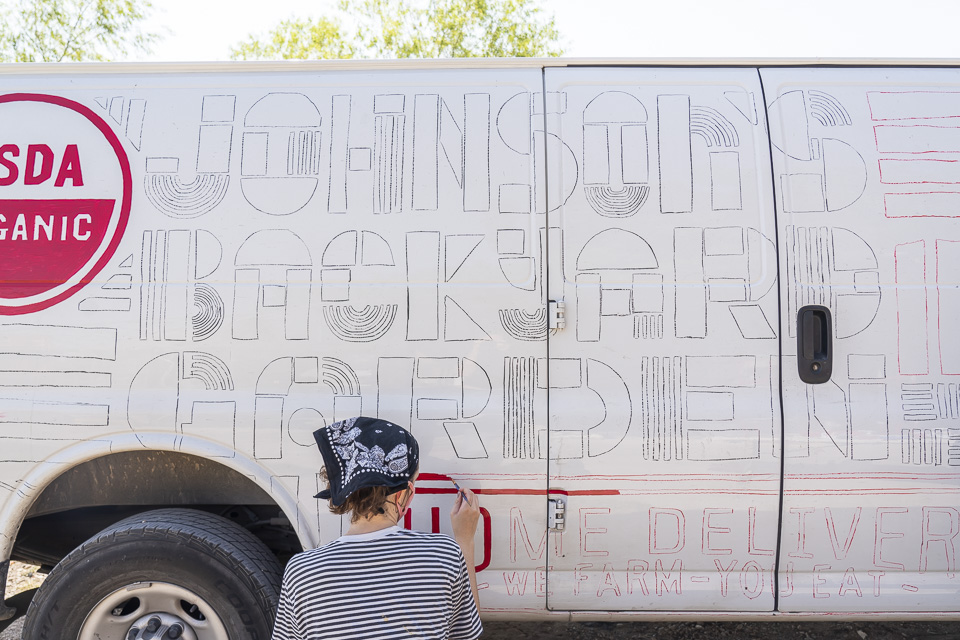 You'll never finish if you don't start. Photo by Scott David Gordon.
You'll never finish if you don't start. Photo by Scott David Gordon.
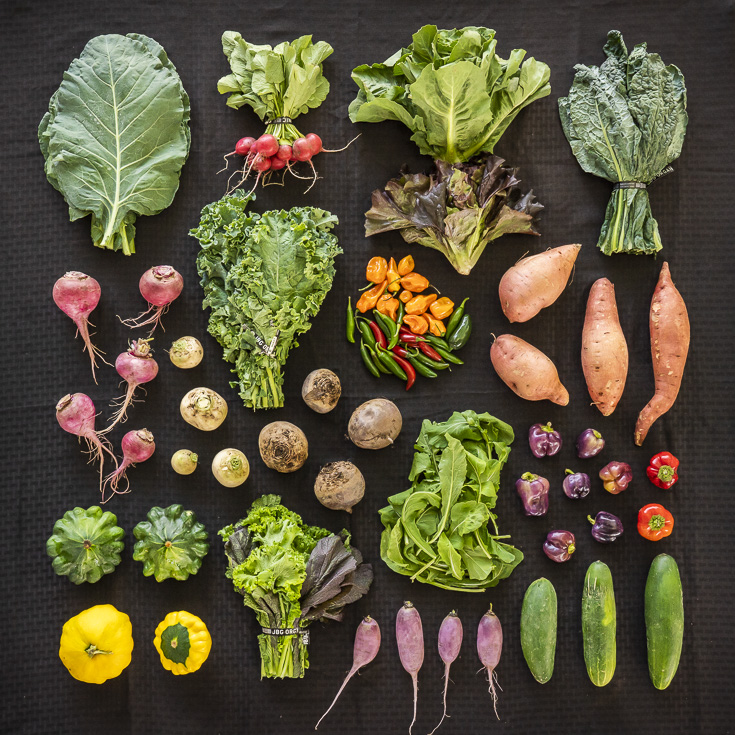
 Long-time JBG team member Lyndsie is heading up this paint project. She may be masked, but we'd recognize that side pony anywhere. Photo by Scott David Gordon.
Long-time JBG team member Lyndsie is heading up this paint project. She may be masked, but we'd recognize that side pony anywhere. Photo by Scott David Gordon.
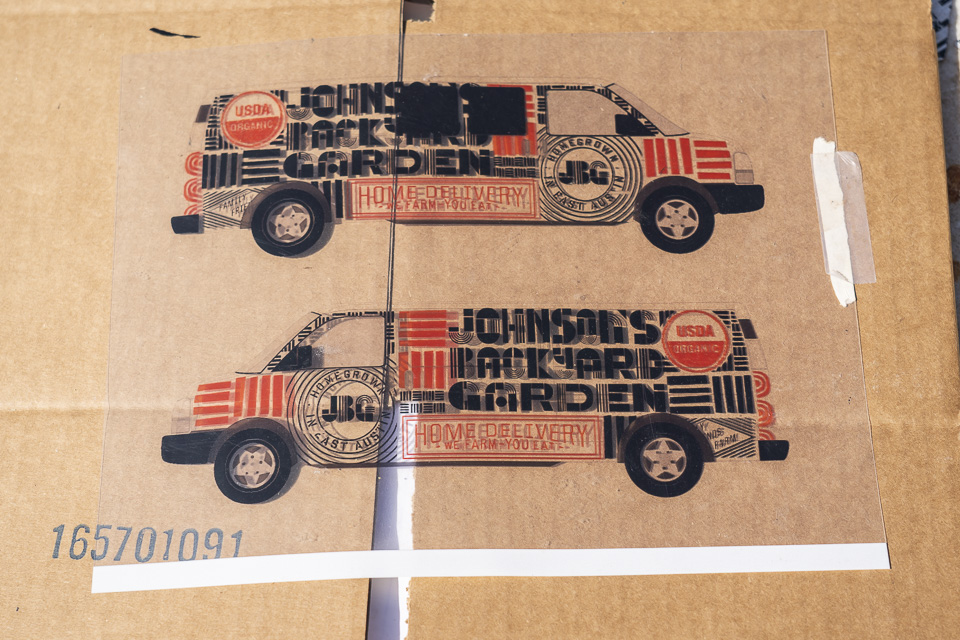 Lyndsie used transparencies and an old-school projector to trace the designs onto our vans. Photo by Scott David Gordon.
Lyndsie used transparencies and an old-school projector to trace the designs onto our vans. Photo by Scott David Gordon.
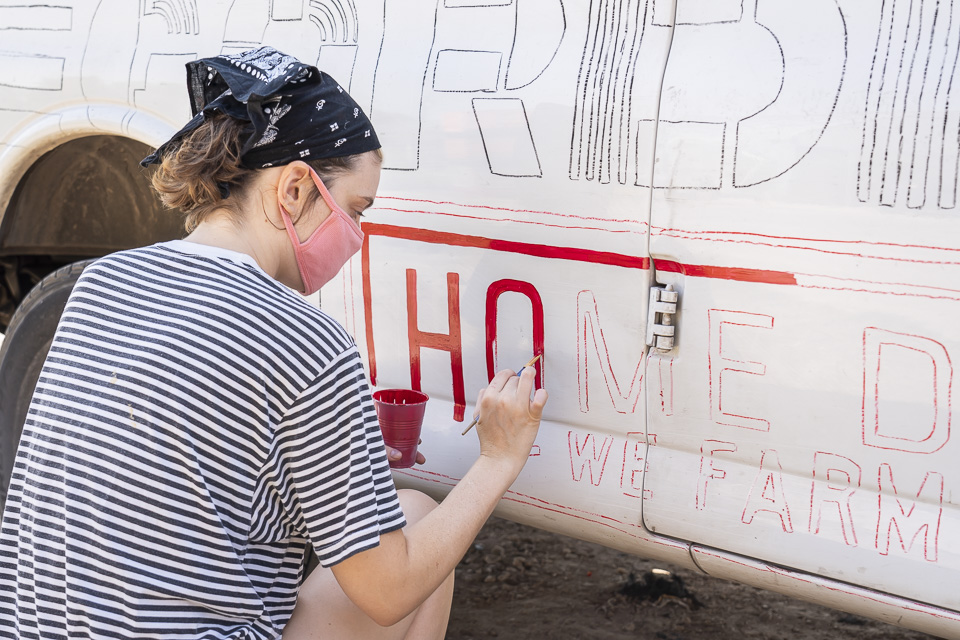 You gotta start somewhere. Photo by Scott David Gordon.
You gotta start somewhere. Photo by Scott David Gordon.
 We're so grateful to our volunteers that lent a steady hand to this project! Photo by Scott David Gordon.
We're so grateful to our volunteers that lent a steady hand to this project! Photo by Scott David Gordon.
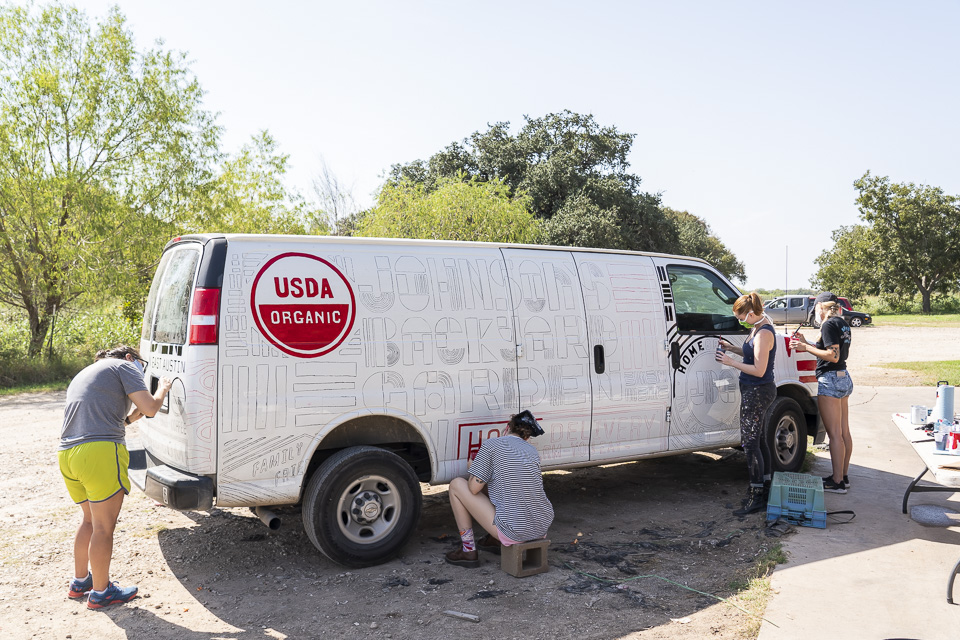 Cinder block seats and a bluebird sky. What more could you want in a day? Photo by Scott David Gordon.
Cinder block seats and a bluebird sky. What more could you want in a day? Photo by Scott David Gordon.
 As you may know, we've put a pause on our volunteer program for the past 6 months. We've made an exception for this special project, and it feels wonderful to welcome so new faces to the farm. Photo by Scott David Gordon.
As you may know, we've put a pause on our volunteer program for the past 6 months. We've made an exception for this special project, and it feels wonderful to welcome so new faces to the farm. Photo by Scott David Gordon.
 Homegrown in East Austin circles the letters JBG, made up with blocks and lines just like the layout of the farm fields. Photo by Scott David Gordon.
Homegrown in East Austin circles the letters JBG, made up with blocks and lines just like the layout of the farm fields. Photo by Scott David Gordon.
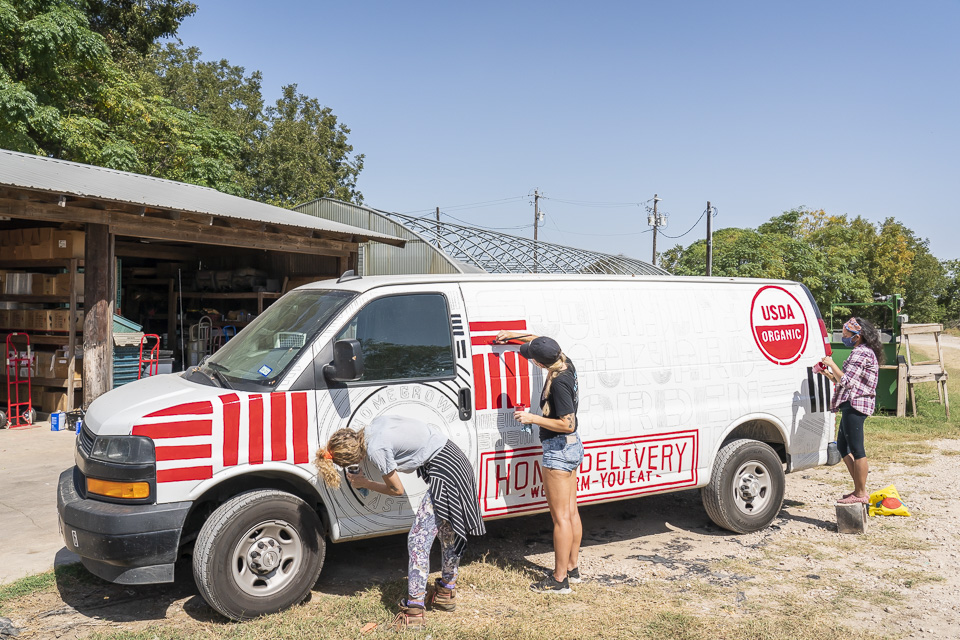 We love the transformation from a boring white van to a branded veggie mobile, bright with color and ripe with potential! Photo by Scott David Gordon.
We love the transformation from a boring white van to a branded veggie mobile, bright with color and ripe with potential! Photo by Scott David Gordon.
 Even though our veggies are now technically grown at the farm, they started off as homegrown offerings from Brenton's backyard on Holly Street. Photo by Scott David Gordon.
Even though our veggies are now technically grown at the farm, they started off as homegrown offerings from Brenton's backyard on Holly Street. Photo by Scott David Gordon.
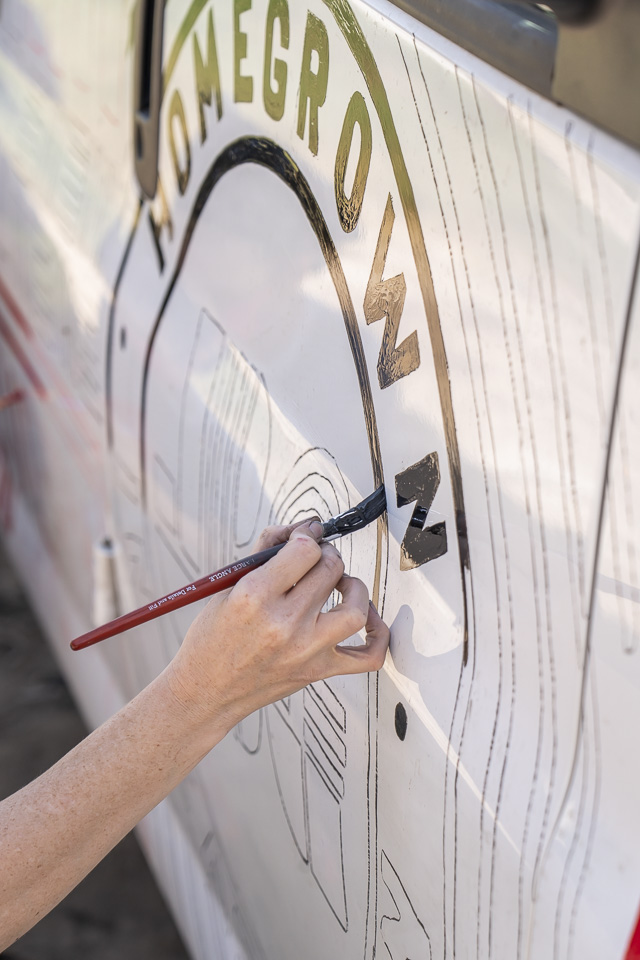 The pinkies are how you know they're professionals. Photo by Scott David Gordon.
The pinkies are how you know they're professionals. Photo by Scott David Gordon.
 Farmers are artists, too! Photo by Scott David Gordon.
Farmers are artists, too! Photo by Scott David Gordon.
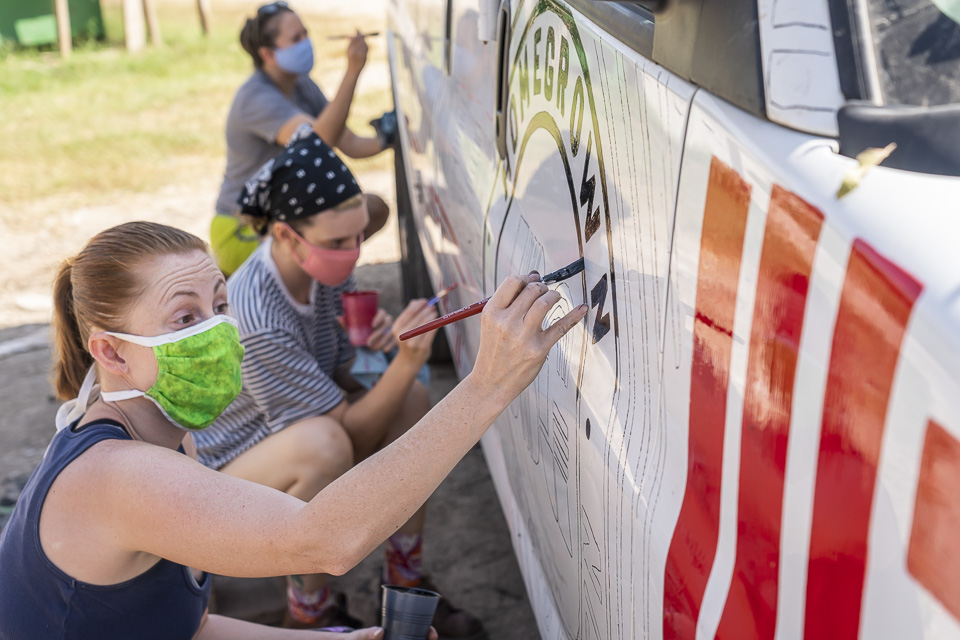 Lots of concentration, and some fun too :) Photo by Scott David Gordon.
Lots of concentration, and some fun too :) Photo by Scott David Gordon.
 These are professionals, y'all!
These are professionals, y'all!
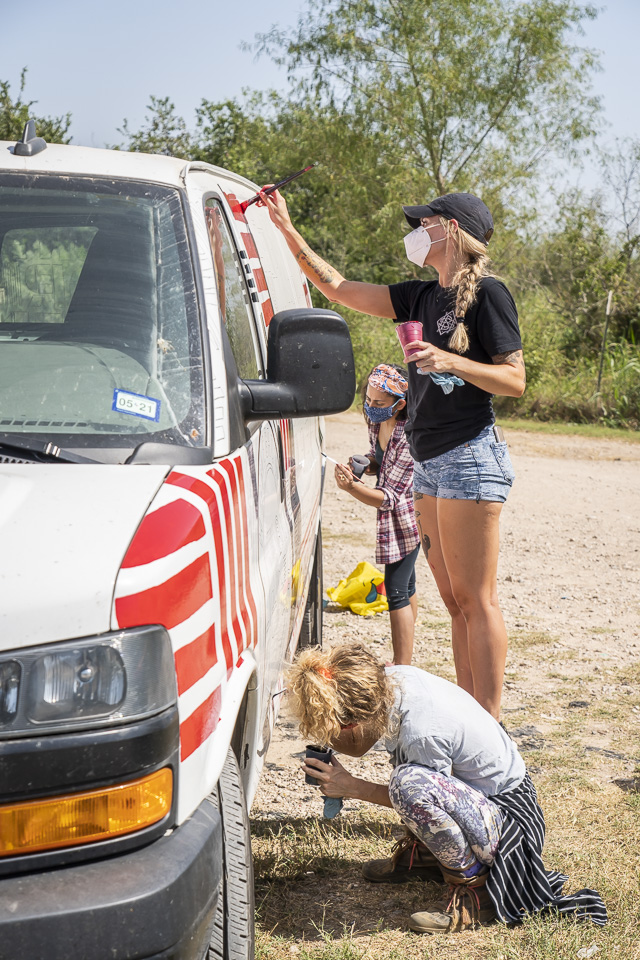 High, medium, low. Photo by Scott David Gordon.
High, medium, low. Photo by Scott David Gordon.
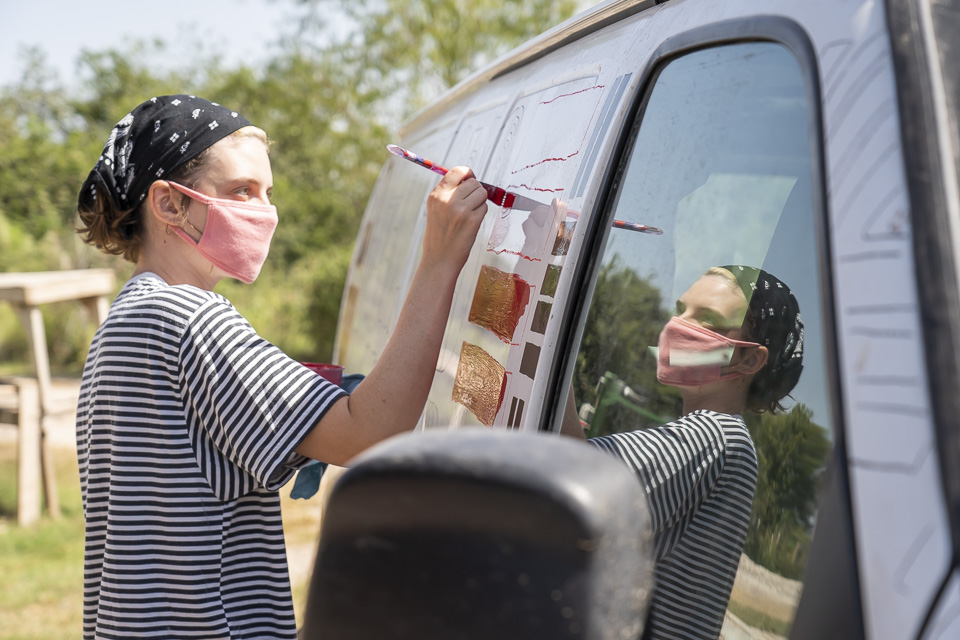 Thanks again to the wonderful women who helped paint our new delivery truck!! Photo by Scott David Gordon.
Thanks again to the wonderful women who helped paint our new delivery truck!! Photo by Scott David Gordon.
Do you have studio art or painting experience? Does this volunteer opportunity sound like something you'd like to do? Email Ada (ada@jbgorganic.com) with PAINT in the subject line to get notified when we schedule our next paint day. Please makes sure to mention your artistic experience. All volunteers are thanked with a box of veggies and the satisfaction of knowing you beautified a van.
CSA BOX CONTENTS WEEK OF OCT 12
10/09/20 — Farm
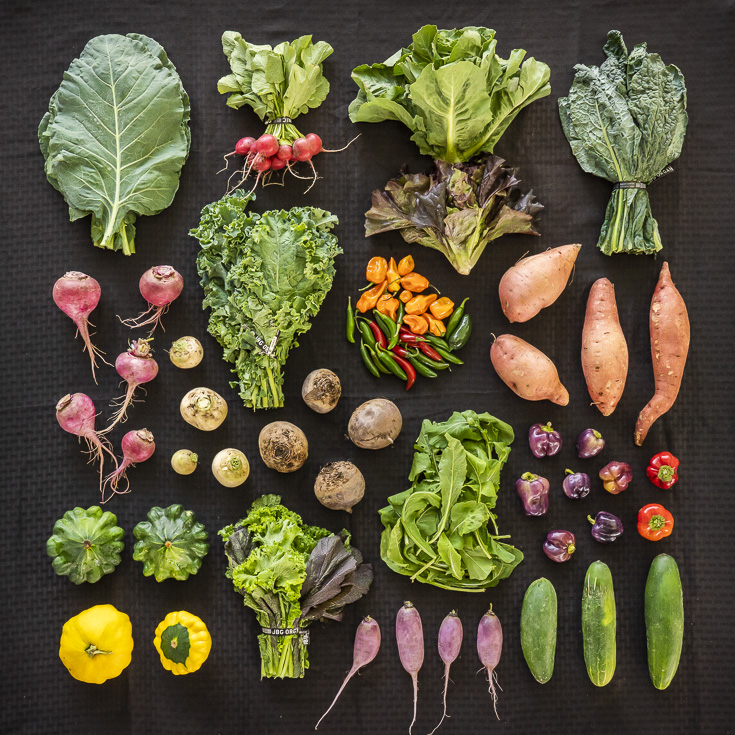 CSA Box Contents Week of Oct 12th
CSA Box Contents Week of Oct 12th
Individual: Kale, Herb, Sweet Peppers, Sweet Potato, Squash, Turnip
Small: Beets, Arugula, Collards, Kale, Herb, Squash, Turnip
Medium: Beets, Farmers Choice, Collards, Greens, Kale, Cilantro, Multiplying Onion, Hot Peppers, Sweet Potato, Squash
Large: Beets, Cucumber, Farmers Choice, Collards, Greens, Kale, Herb, Lettuce, Multiplying Onion, Hot Peppers, Sweet Peppers, Squash, Turnip
FIVE PERKS OF BEING A CSA MEMBER
10/09/20 — Ada Broussard
This is the time of year when our CSA boxes are brimming with variety. Summer crops mingle with winter ones, and our CSA shares are truly their best selves. If you’re currently a CSA Member, we wanted to remind you of some of the perks that come along with being a member. And if you’re considering signing up, we wanted to remind you of your potential perks waiting for you when you join the club.
![]() Your CSA Membership is a handshake deal with our farm. And we work really hard not to disappoint!
Your CSA Membership is a handshake deal with our farm. And we work really hard not to disappoint!
![]() The vegetables hidden in these boxes are always grown by JBG farmers. You can rest assured that they're always safe, fresh... and delicious.
The vegetables hidden in these boxes are always grown by JBG farmers. You can rest assured that they're always safe, fresh... and delicious.
Another CSA Perk that is unique to our program is the ability to customize your box. We’re lucky enough to have a farmer (Brenton) whose brother (Aaron) is a talented web developer. Years ago, Aaron developed some software that allows our customers to swap out two vegetables they won’t want for ones they’d prefer. We love that we’re able to offer you this choice and as simple as this process may sound, it has actually taken years to refine. If you’ve been a member for a while, you might know that we had to press pause our customization feature at the beginning of the pandemic… in case you didn’t realize, it’s back!
![]() Aaron and his wife Sherry (right) chatting with Brenton and Kimberly at last March's Spring Picnic. Thanks Aaron for making our CSA dreams come true!
Aaron and his wife Sherry (right) chatting with Brenton and Kimberly at last March's Spring Picnic. Thanks Aaron for making our CSA dreams come true!
![]() Have a friend that might like the CSA? Do us a favor and tell them about it! It's the kind thing to do.
Have a friend that might like the CSA? Do us a favor and tell them about it! It's the kind thing to do.
![]() A (pre-Covid) scene from a local market. Can't you see the glimmer in our eye? CSA Members are our favorite!
A (pre-Covid) scene from a local market. Can't you see the glimmer in our eye? CSA Members are our favorite!
![]() If you follow us on Instagram, click on the TV icon at the top of our profile to see Hector's weekly "CSA PSA" videos. If you're new to the CSA, Hector will help you id the veggies... and figure out how to cook them!
If you follow us on Instagram, click on the TV icon at the top of our profile to see Hector's weekly "CSA PSA" videos. If you're new to the CSA, Hector will help you id the veggies... and figure out how to cook them!
Till next time!
![]()
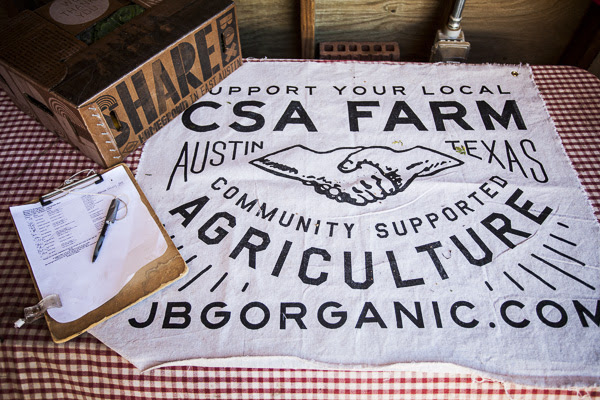 Your CSA Membership is a handshake deal with our farm. And we work really hard not to disappoint!
Your CSA Membership is a handshake deal with our farm. And we work really hard not to disappoint!
PERK 1: First Dibs
As you might know, the vegetables we grow at JBG get pumped into the community in three main channels: at farmers’ markets, through restaurants and grocery stores, and through our CSA Program. If you’re a member reading this, we’re happy to inform you that you always get first dibs on the highest quality crops as well as the newest, most exciting crops. When a new crop makes its seasonal debut, it usually trickles in slowly, one harvest case at a time. During this initial period when there is only a limited quantity of the vegetable, we always make sure it’s allocated to CSA Members. CSA Perk number one: You get the first taste of seasonal shifts. We farm to please!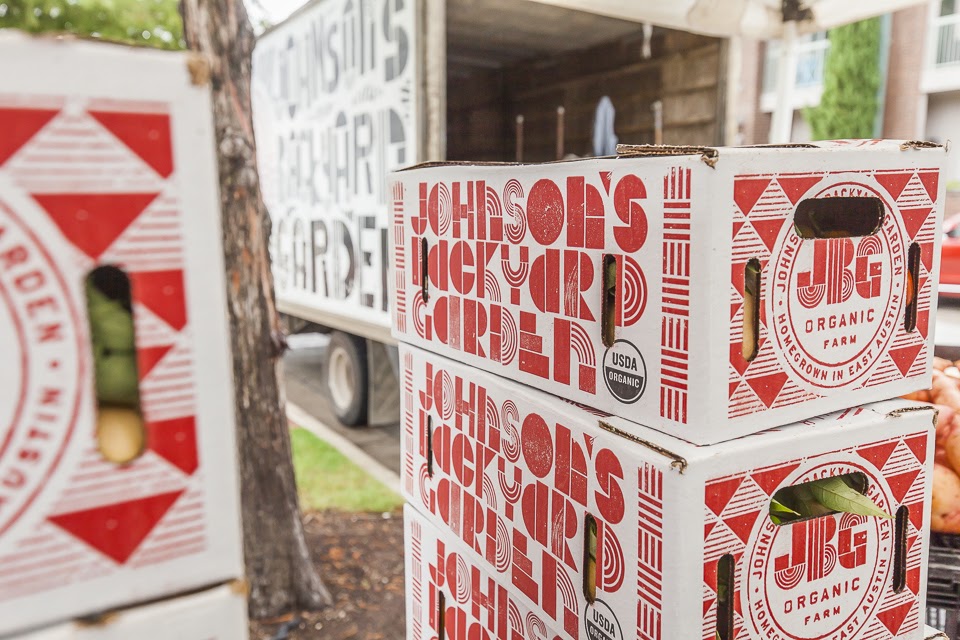 The vegetables hidden in these boxes are always grown by JBG farmers. You can rest assured that they're always safe, fresh... and delicious.
The vegetables hidden in these boxes are always grown by JBG farmers. You can rest assured that they're always safe, fresh... and delicious.
PERK 2: Fresh + Customized
Our farm’s CSA program is unique in several ways. First, it’s a true CSA! This means that all of the vegetables that arrive on your doorstep are planted, grown, and harvested by JBG employees at our Garfield, Texas farm. We can even tell you the block they were picked from if you’d like. Unlike other delivery services that aggregate vegetables from many sources, you can rest easy knowing exactly where your veggies come from. The biggest benefit of getting your vegetables straight from a farm? They’re fresh beyond comparison, spending no time in a storage facility or unnecessary transit. We harvest, pack, and then deliver our vegetables straight to you, meaning they end up on your chopping block very close to their harvest date. Fresh vegetables equate to more nutritious and delicious meals.Another CSA Perk that is unique to our program is the ability to customize your box. We’re lucky enough to have a farmer (Brenton) whose brother (Aaron) is a talented web developer. Years ago, Aaron developed some software that allows our customers to swap out two vegetables they won’t want for ones they’d prefer. We love that we’re able to offer you this choice and as simple as this process may sound, it has actually taken years to refine. If you’ve been a member for a while, you might know that we had to press pause our customization feature at the beginning of the pandemic… in case you didn’t realize, it’s back!
 Aaron and his wife Sherry (right) chatting with Brenton and Kimberly at last March's Spring Picnic. Thanks Aaron for making our CSA dreams come true!
Aaron and his wife Sherry (right) chatting with Brenton and Kimberly at last March's Spring Picnic. Thanks Aaron for making our CSA dreams come true!
PERK 3: Referral Program
CSA Members, did you know we have a CSA Referal Program? We’ve found that one of our best marketing tools is word of mouth. Each Fall, when our fields are overflowing with vegetables, we are in a position to welcome new members to the club. If you enjoy the experience of being a CSA Member and find yourself cooking vegetable dishes more dazzling than you ever thought possible, consider referring a friend. Now is the ideal time - the variety in boxes will peak in the coming month! If your friend signs up using your referral code, you’ll get $20 towards your next subscription and they’ll get a free box. Sound too good to be true? It might be… so don’t dally and refer a friend soon. You can find your referral code by logging into your account. It is on the top right corner of the “My Deliveries” page. Shoot us a message if you have questions. Have a friend that might like the CSA? Do us a favor and tell them about it! It's the kind thing to do.
Have a friend that might like the CSA? Do us a favor and tell them about it! It's the kind thing to do.
PERK 4: Apple of our Eye
How do we say this…. You’re our favorite child. Our CSA Program really is the bread and butter of our farm, and we hope to treat you as such. You’re the dill to our pickle, the apple of our eye. Sure, we love the fact that our veggies are on restaurant menus and grocery store shelves, but there is something so special about the direct relationship we have with our CSA Members… members of our community that have so much faith in our farming operation that they’ll pay us upfront for a season of veggies. We don’t take this responsibility lightly, and we are always working our hardest with your food in mind. Being a favorite child definitely has it’s perks, and if you join the CSA you’ll know what we mean.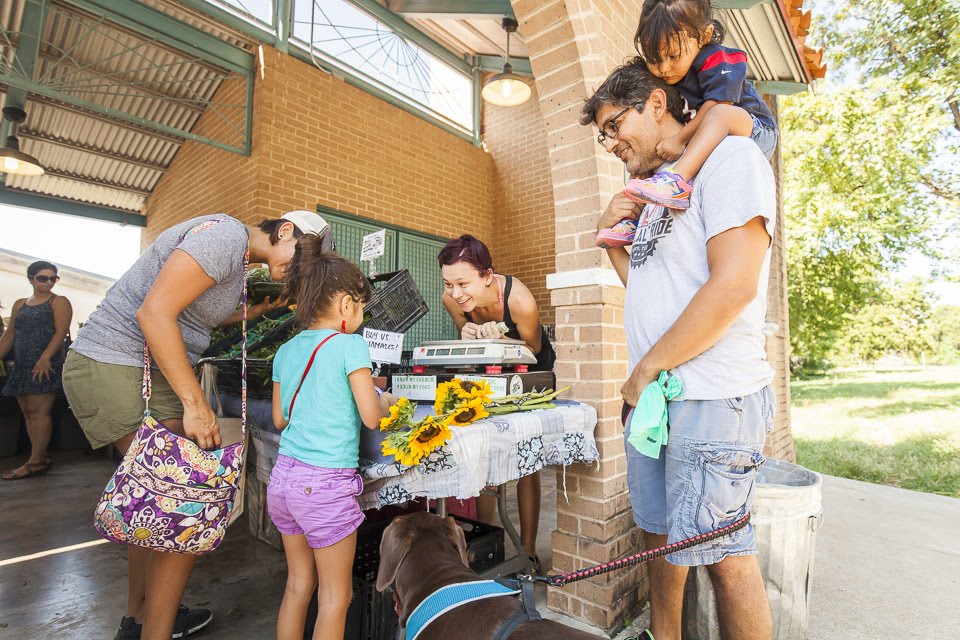 A (pre-Covid) scene from a local market. Can't you see the glimmer in our eye? CSA Members are our favorite!
A (pre-Covid) scene from a local market. Can't you see the glimmer in our eye? CSA Members are our favorite!
PERK 5: Your Own Personal Farmer
When you join the CSA, you’re basically joining forces with a team of professional farmers to help you eat seasonally and become a vegetable wizard. We’re here to help you on this journey, and love when members shoot us messages asking “How do I cook these beets?!”. If you don’t know how to chop, store, or prepare a veggie, we’re here to help. Think of our 512 phone number as your own personal veggie hotline. You can get in touch on social media, too. Here is a link to our Instagram and another to our Facebook. We even tweet. Most Wednesdays, our social media Manager, Hector, usually does a “CSA PSA” where he unpacks a Medium CSA box and unveils his meal prep plan for the week. If you’re new to the CSA and are having trouble identifying all the veggies (or just knowing what to do with them!) consider tuning in… Hector’s an amazing cook and always has great ideas. If you follow us on Instagram, click on the TV icon at the top of our profile to see Hector's weekly "CSA PSA" videos. If you're new to the CSA, Hector will help you id the veggies... and figure out how to cook them!
If you follow us on Instagram, click on the TV icon at the top of our profile to see Hector's weekly "CSA PSA" videos. If you're new to the CSA, Hector will help you id the veggies... and figure out how to cook them!
Till next time!
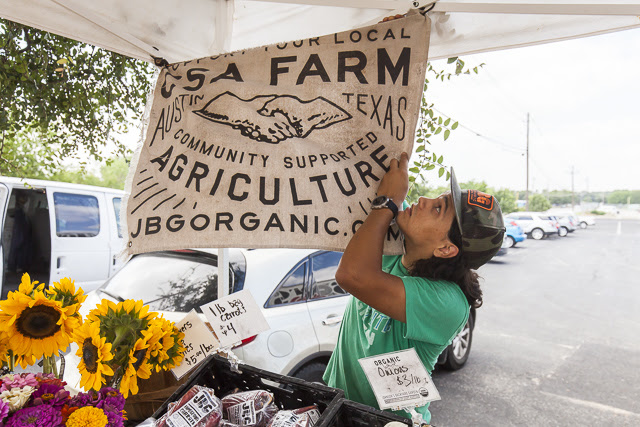
CSA BOX CONTENTS WEEK OF OCT 5
10/05/20 — Ada Broussard
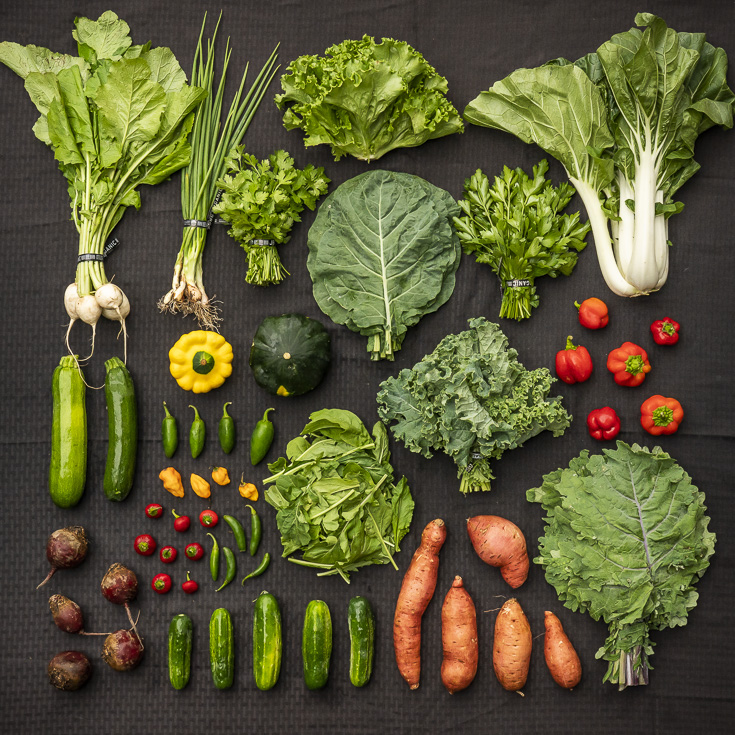 CSA Box Contents Week of Oct 5th
CSA Box Contents Week of Oct 5th
Individual: Beets, Farmer's Choice, Collard Greens, Herb, Multiplying Onion
Small: Cucumber, Collard Greens, Farmer's Choice Greens, Herb, Multiplying Onion, Sweet Pepper, Sweet Potato
Medium: Bok Choy, Farmer's Choice, Arugula, Collard Greens, Cilantro, Multiplying Onion, Hot Pepper Medley, Sweet Potato, Patty Pan Squash, White Japanese Turnip
Large: Bok Choy, Collard Greens, Curly Kale, Cilantro, Green Leaf Lettuce, Multiplying Onion, Hot Pepper Medley, Sweet Potato, Radish, Patty Pan Squash, White Japanese Turnip
PHOTOS FROM THE FARM: 10.2.2020
10/02/20 — Ada Broussard
This week on our main blog post we're talking about the seasonal transition we're currently experiencing at the farm. Cool-weather crops abound, and the abundance of collards and kale will soon surpass that of warm-weather vegetables like eggplant and okra. But for now, everyone exists together in perfect harmony. Thanks for capturing this exciting moment in the season, Scott!
![]() Collard greens have arrived! Photo by Scott David Gordon.
Collard greens have arrived! Photo by Scott David Gordon.
![]() For a farmer, there is nothing like the feeling of a beautifully amended, shaped, flame weeded, and irrigated bed, ready for planting. Photo by Scott David Gordon.
For a farmer, there is nothing like the feeling of a beautifully amended, shaped, flame weeded, and irrigated bed, ready for planting. Photo by Scott David Gordon.
![]() (Very) early morning okra. Photo by Scott David Gordon.
(Very) early morning okra. Photo by Scott David Gordon.
![]() How many ready-to-pick okra pods can you spy? Photo by Scott David Gordon.
How many ready-to-pick okra pods can you spy? Photo by Scott David Gordon.
![]() That time of year when the morning eggplant harvest requires a winter hat. We're in heaven with these cooler temperatures. Photo by Scott David Gordon.
That time of year when the morning eggplant harvest requires a winter hat. We're in heaven with these cooler temperatures. Photo by Scott David Gordon.
![]() The longest shadows. Photo by Scott David Gordon.
The longest shadows. Photo by Scott David Gordon.
![]() Acres of eggplant ready for market. Photo by Scott David Gordon.
Acres of eggplant ready for market. Photo by Scott David Gordon.
![]() Empty bins, full hands. Photo by Scott David Gordon.
Empty bins, full hands. Photo by Scott David Gordon.
![]() Sexy soil, if we do say so ourselves. Photo by Scott David Gordon.
Sexy soil, if we do say so ourselves. Photo by Scott David Gordon.
![]() Transplants, transplants, transplants. Photo by Scott David Gordon.
Transplants, transplants, transplants. Photo by Scott David Gordon.
![]() John-Mark jumping into his office! Photo by Scott David Gordon.
John-Mark jumping into his office! Photo by Scott David Gordon.
![]() Sweet potatoes coming out of the ground, still attached to the vines. Photo by Scott David Gordon.
Sweet potatoes coming out of the ground, still attached to the vines. Photo by Scott David Gordon.
![]() Curly parsley transplants reaching for the sun and begging to be planted! Photo by Scott David Gordon.
Curly parsley transplants reaching for the sun and begging to be planted! Photo by Scott David Gordon.
![]() Curly parsley transplants going into the ground. Thank you! Photo by Scott David Gordon.
Curly parsley transplants going into the ground. Thank you! Photo by Scott David Gordon.
![]() Collard veins shining bright. Photo by Scott David Gordon.
Collard veins shining bright. Photo by Scott David Gordon.
![]() Red beets are looking beautiful! Photo by Scott David Gordon.
Red beets are looking beautiful! Photo by Scott David Gordon.
![]() Kieley "popping" transplants, or using a small wooden dowel to release the tender plants from the plastic cell trays. We "pop" all of the transplants just before we load them up onto our transplanter implement. Photo by Scott David Gordon.
Kieley "popping" transplants, or using a small wooden dowel to release the tender plants from the plastic cell trays. We "pop" all of the transplants just before we load them up onto our transplanter implement. Photo by Scott David Gordon.
![]() John-Mark getting ready to direct seed some crops. This week's direct-seeded crops included radishes, carrots, and rainbow chard. Photo by Scott David Gordon.
John-Mark getting ready to direct seed some crops. This week's direct-seeded crops included radishes, carrots, and rainbow chard. Photo by Scott David Gordon.
![]() A truckbed of freshly harvested turnips, ready for a trip to the cooler. Photo by Scott David Gordon.
A truckbed of freshly harvested turnips, ready for a trip to the cooler. Photo by Scott David Gordon.
![]() It's been a long time since we've harvested full bins of collards! Let the fun begin! Photo by Scott David Gordon.
It's been a long time since we've harvested full bins of collards! Let the fun begin! Photo by Scott David Gordon.
![]() Bok choy leaves looking divine. Photo by Scott David Gordon.
Bok choy leaves looking divine. Photo by Scott David Gordon.
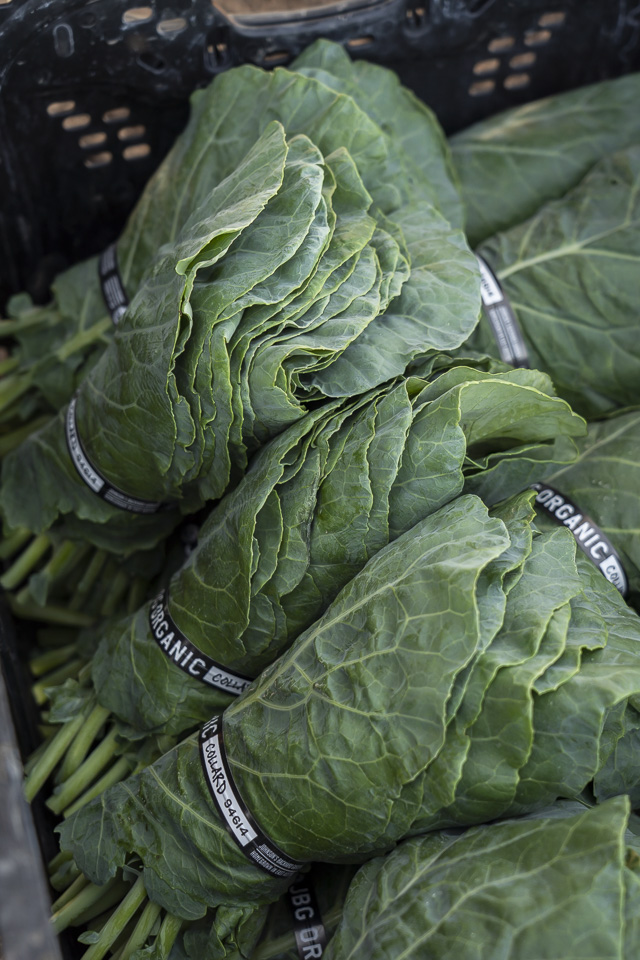 Collard greens have arrived! Photo by Scott David Gordon.
Collard greens have arrived! Photo by Scott David Gordon.
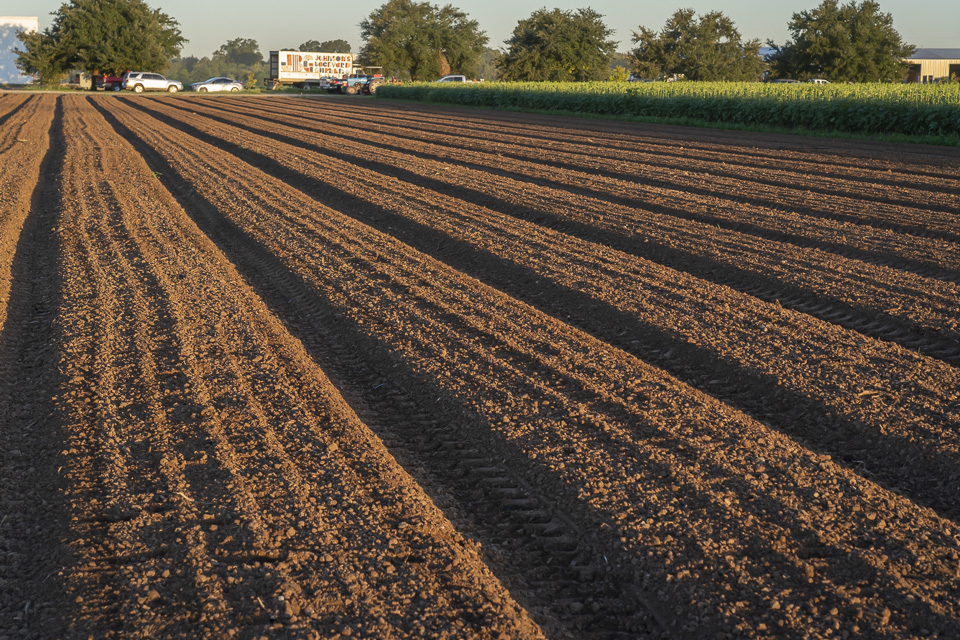 For a farmer, there is nothing like the feeling of a beautifully amended, shaped, flame weeded, and irrigated bed, ready for planting. Photo by Scott David Gordon.
For a farmer, there is nothing like the feeling of a beautifully amended, shaped, flame weeded, and irrigated bed, ready for planting. Photo by Scott David Gordon.
 (Very) early morning okra. Photo by Scott David Gordon.
(Very) early morning okra. Photo by Scott David Gordon.
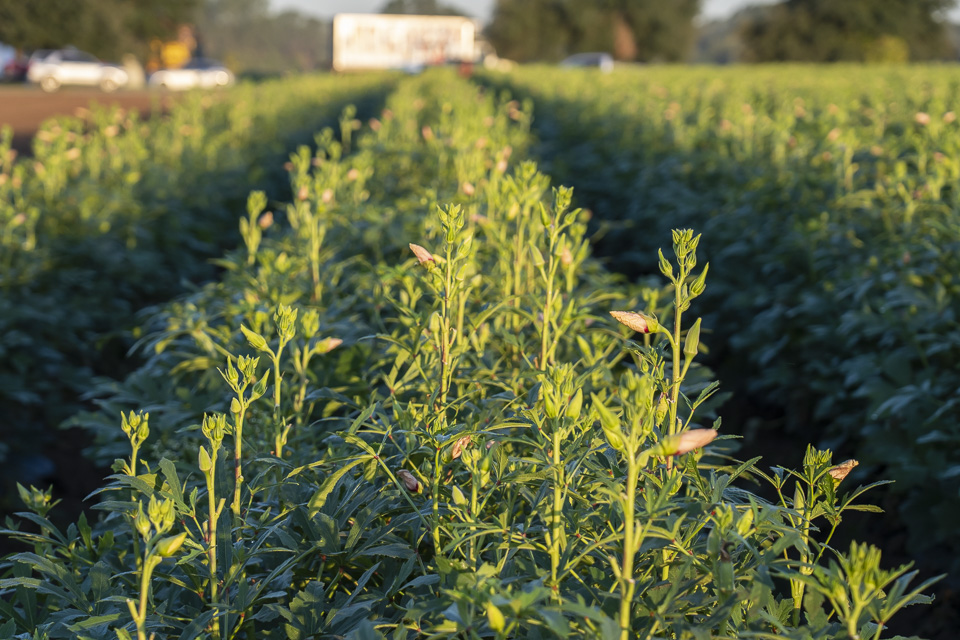 How many ready-to-pick okra pods can you spy? Photo by Scott David Gordon.
How many ready-to-pick okra pods can you spy? Photo by Scott David Gordon.
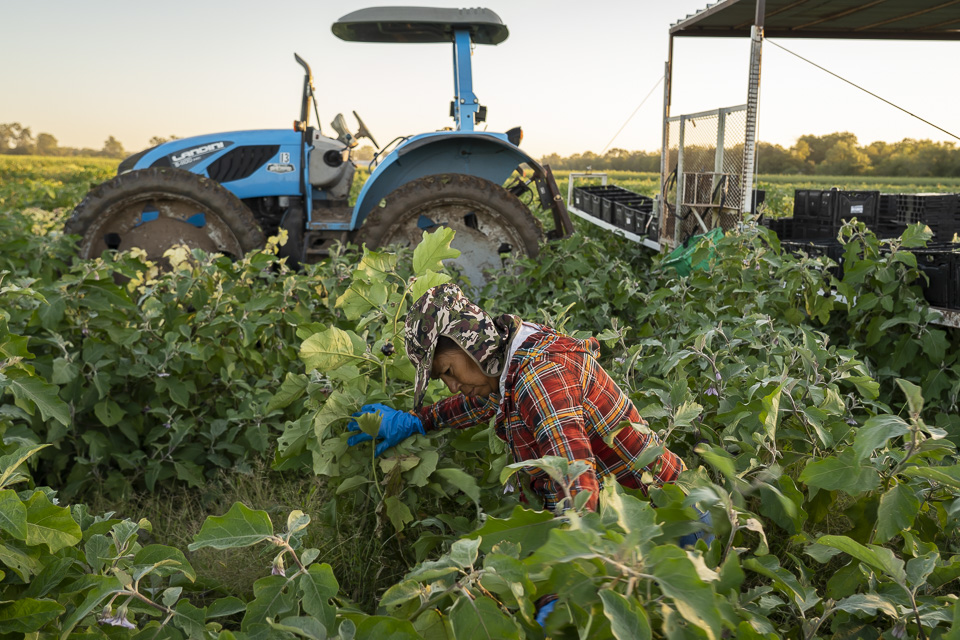 That time of year when the morning eggplant harvest requires a winter hat. We're in heaven with these cooler temperatures. Photo by Scott David Gordon.
That time of year when the morning eggplant harvest requires a winter hat. We're in heaven with these cooler temperatures. Photo by Scott David Gordon.
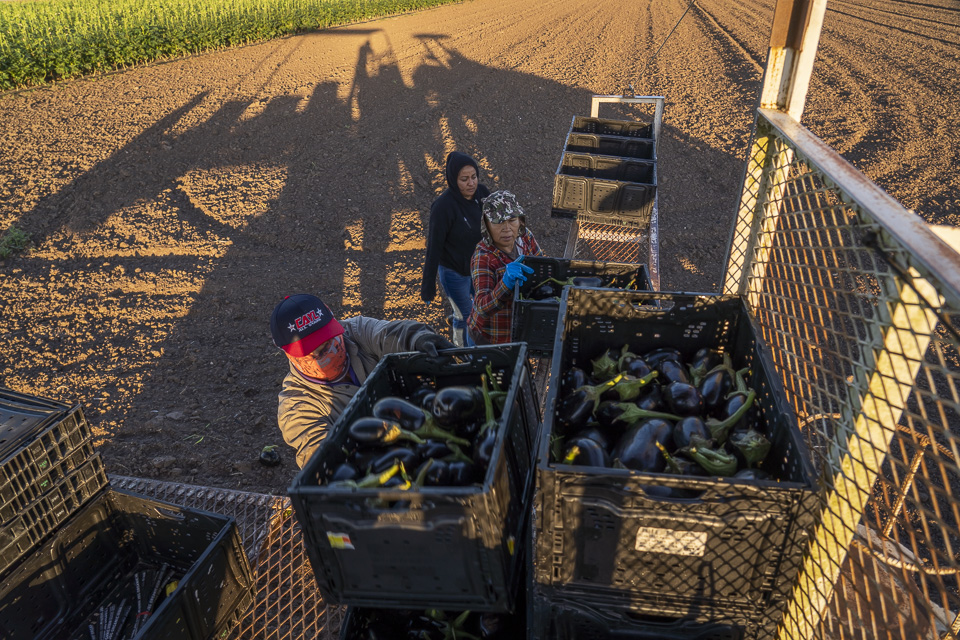 The longest shadows. Photo by Scott David Gordon.
The longest shadows. Photo by Scott David Gordon.
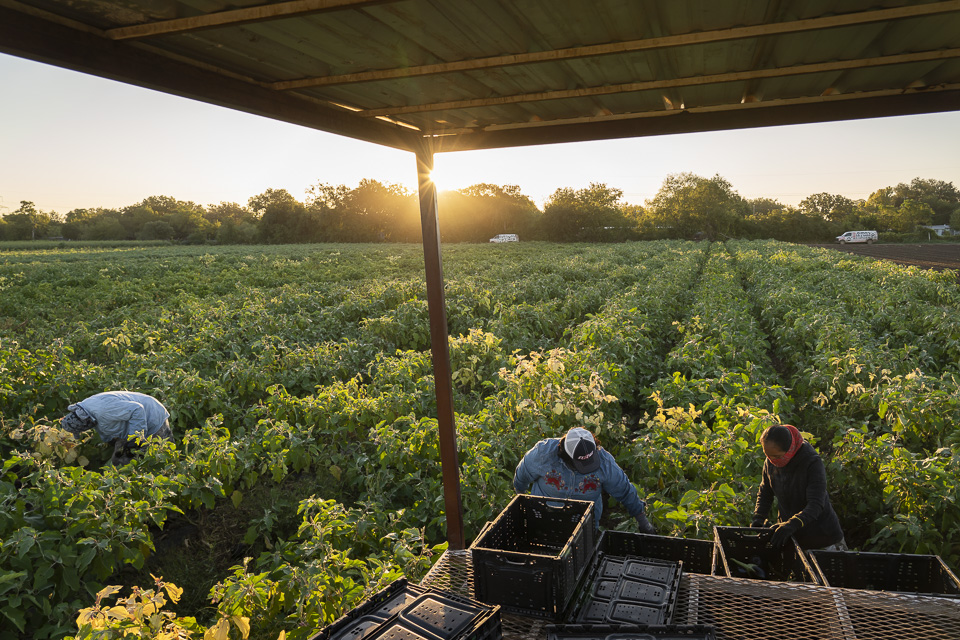 Acres of eggplant ready for market. Photo by Scott David Gordon.
Acres of eggplant ready for market. Photo by Scott David Gordon.
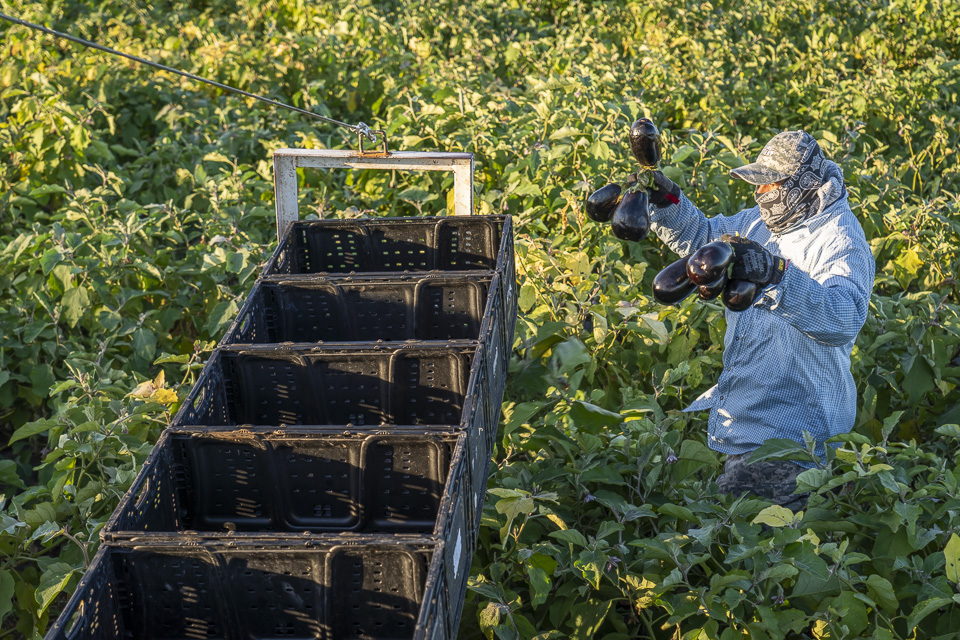 Empty bins, full hands. Photo by Scott David Gordon.
Empty bins, full hands. Photo by Scott David Gordon.
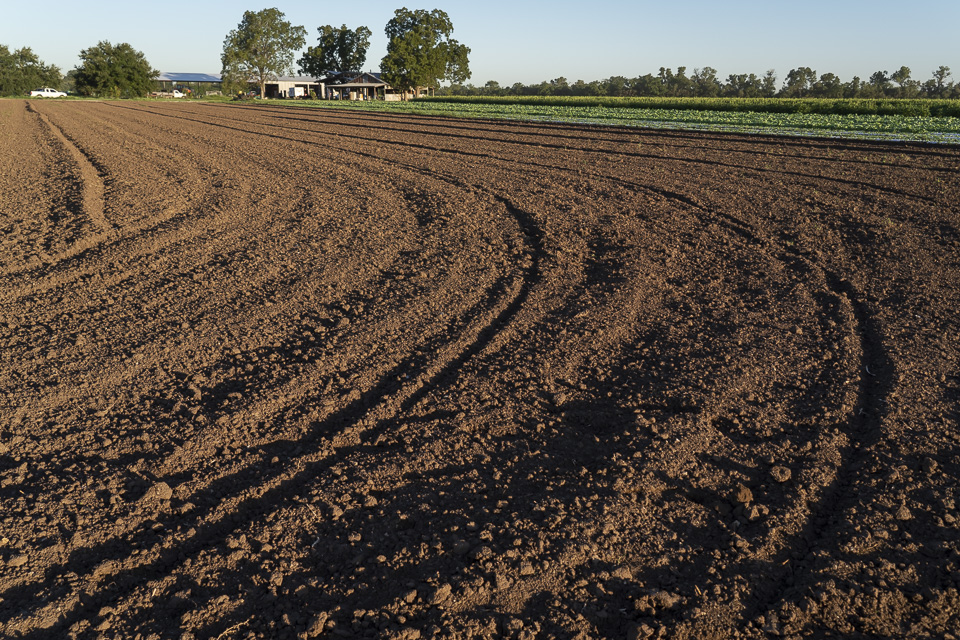 Sexy soil, if we do say so ourselves. Photo by Scott David Gordon.
Sexy soil, if we do say so ourselves. Photo by Scott David Gordon.
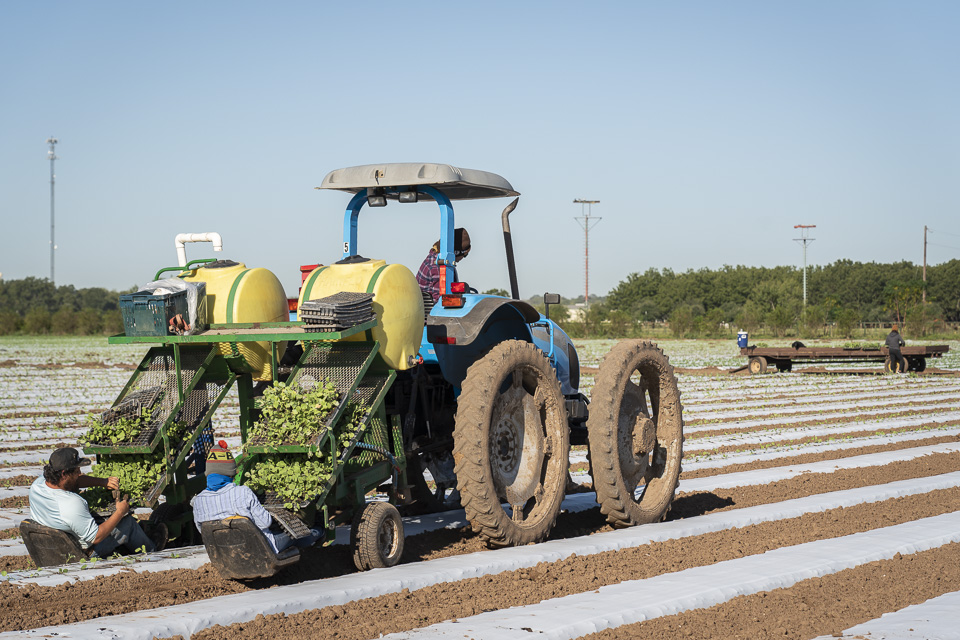 Transplants, transplants, transplants. Photo by Scott David Gordon.
Transplants, transplants, transplants. Photo by Scott David Gordon.
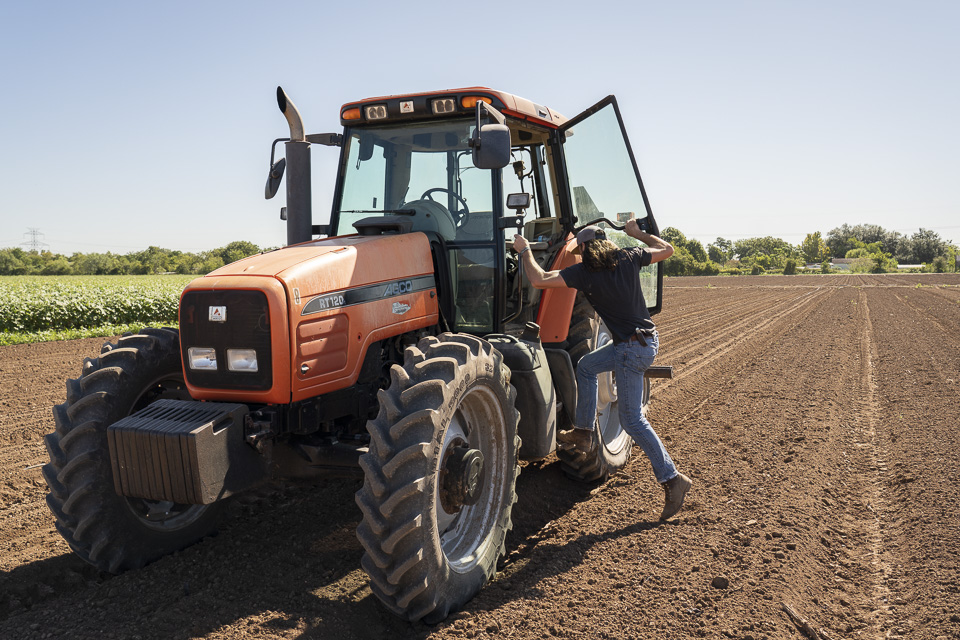 John-Mark jumping into his office! Photo by Scott David Gordon.
John-Mark jumping into his office! Photo by Scott David Gordon.
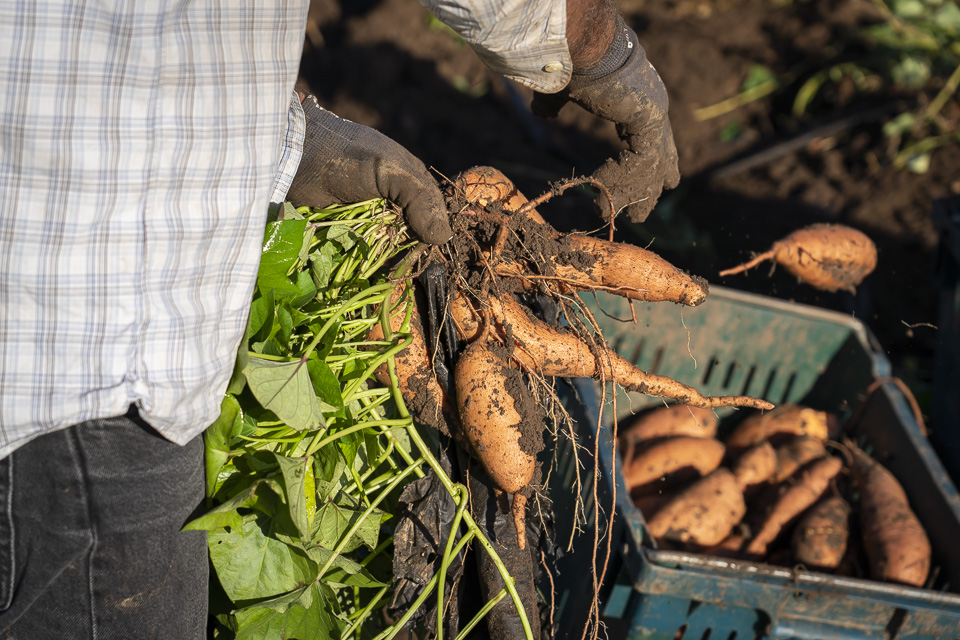 Sweet potatoes coming out of the ground, still attached to the vines. Photo by Scott David Gordon.
Sweet potatoes coming out of the ground, still attached to the vines. Photo by Scott David Gordon.
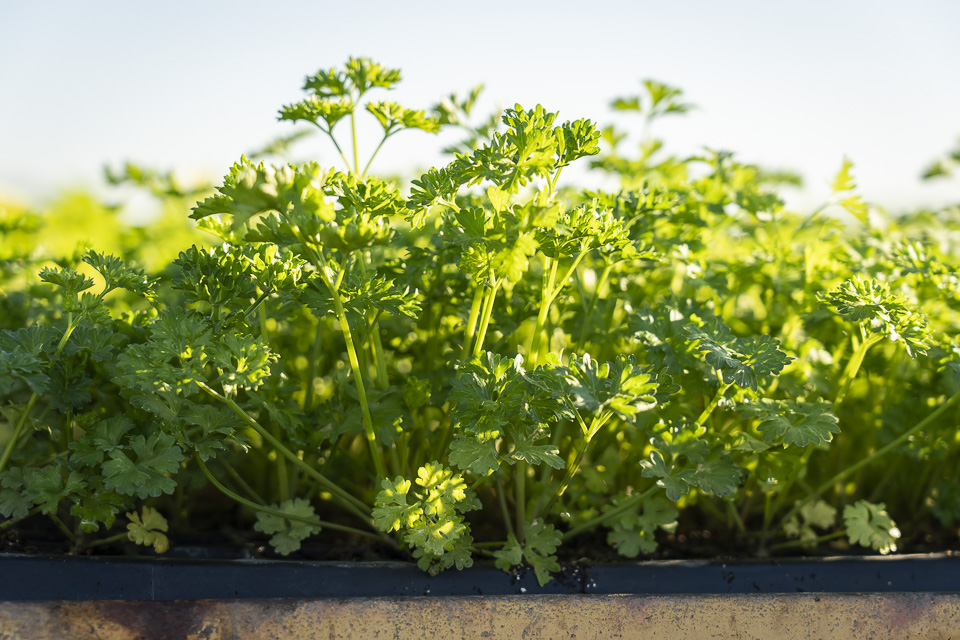 Curly parsley transplants reaching for the sun and begging to be planted! Photo by Scott David Gordon.
Curly parsley transplants reaching for the sun and begging to be planted! Photo by Scott David Gordon.
 Curly parsley transplants going into the ground. Thank you! Photo by Scott David Gordon.
Curly parsley transplants going into the ground. Thank you! Photo by Scott David Gordon.
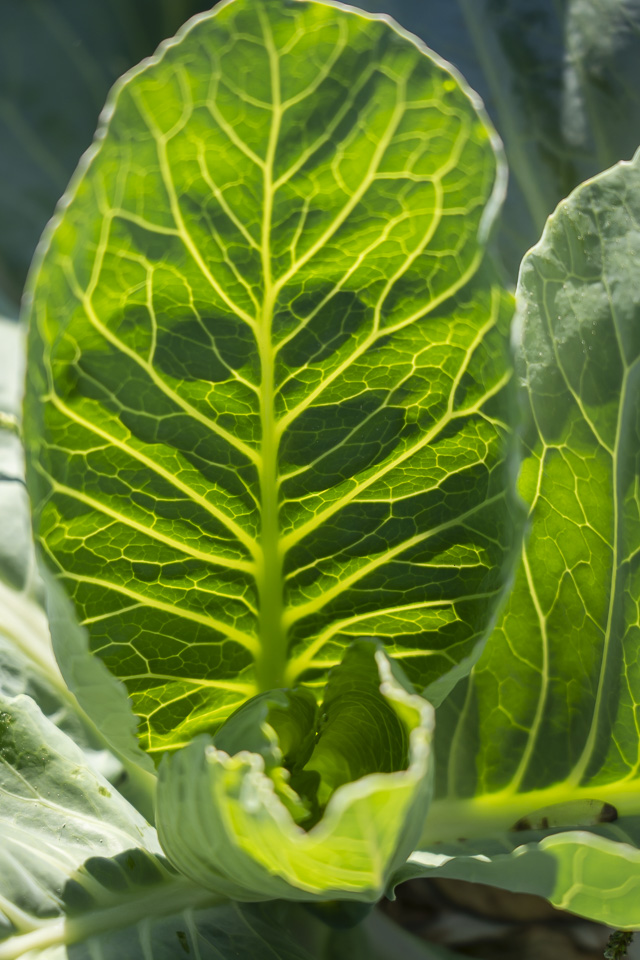 Collard veins shining bright. Photo by Scott David Gordon.
Collard veins shining bright. Photo by Scott David Gordon.
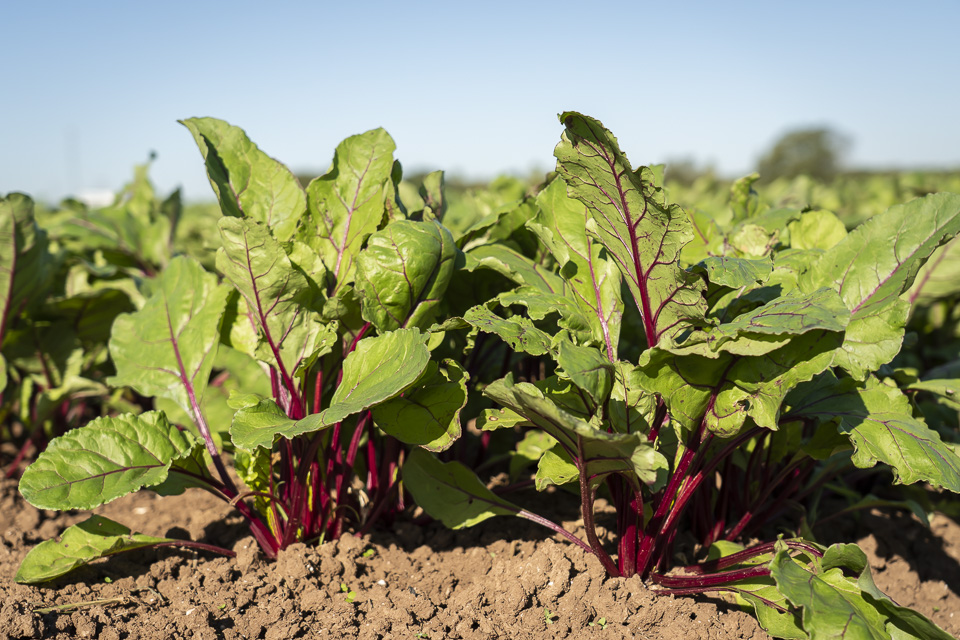 Red beets are looking beautiful! Photo by Scott David Gordon.
Red beets are looking beautiful! Photo by Scott David Gordon.
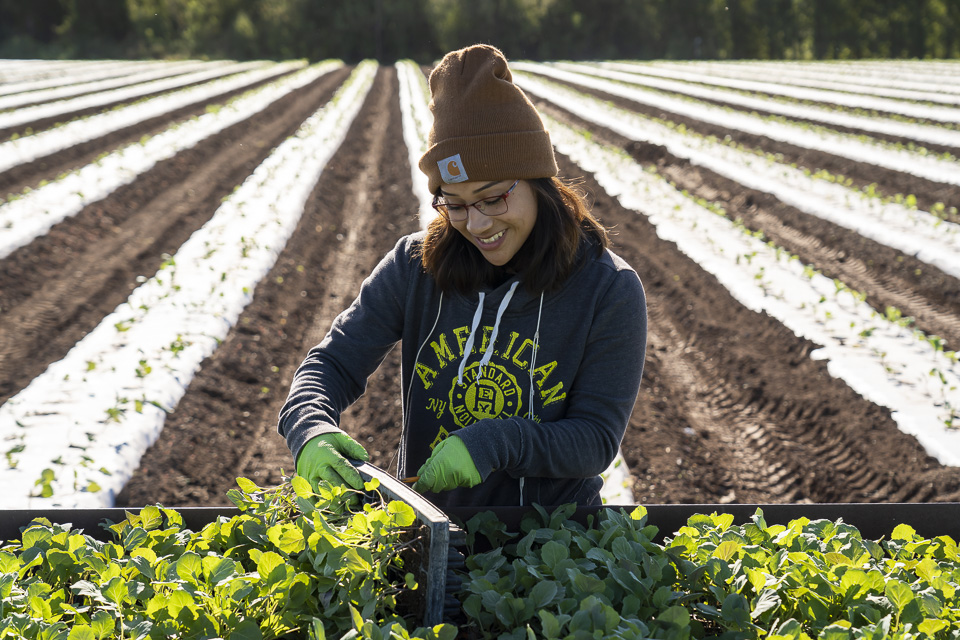 Kieley "popping" transplants, or using a small wooden dowel to release the tender plants from the plastic cell trays. We "pop" all of the transplants just before we load them up onto our transplanter implement. Photo by Scott David Gordon.
Kieley "popping" transplants, or using a small wooden dowel to release the tender plants from the plastic cell trays. We "pop" all of the transplants just before we load them up onto our transplanter implement. Photo by Scott David Gordon.
 John-Mark getting ready to direct seed some crops. This week's direct-seeded crops included radishes, carrots, and rainbow chard. Photo by Scott David Gordon.
John-Mark getting ready to direct seed some crops. This week's direct-seeded crops included radishes, carrots, and rainbow chard. Photo by Scott David Gordon.
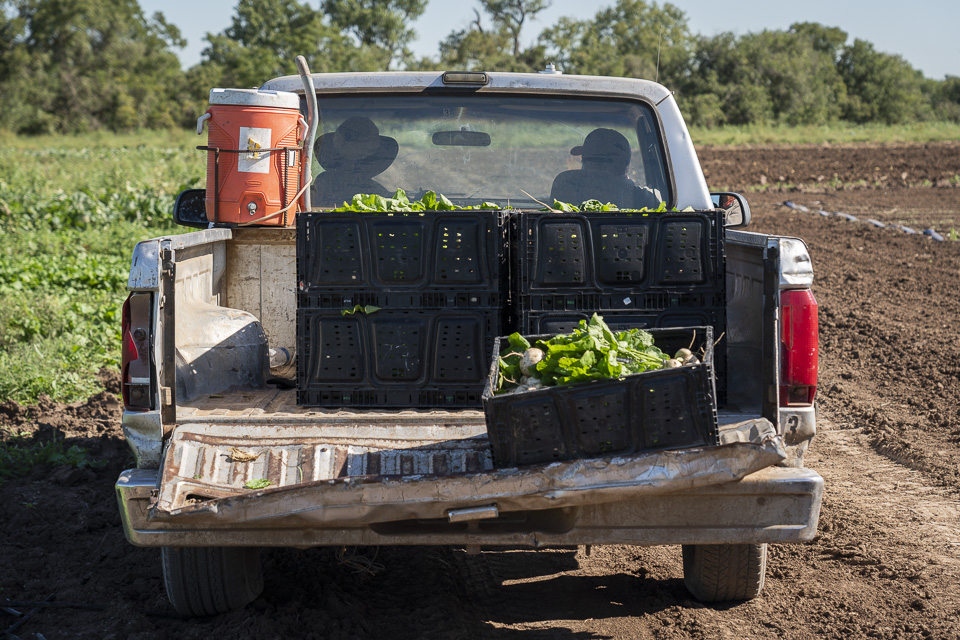 A truckbed of freshly harvested turnips, ready for a trip to the cooler. Photo by Scott David Gordon.
A truckbed of freshly harvested turnips, ready for a trip to the cooler. Photo by Scott David Gordon.
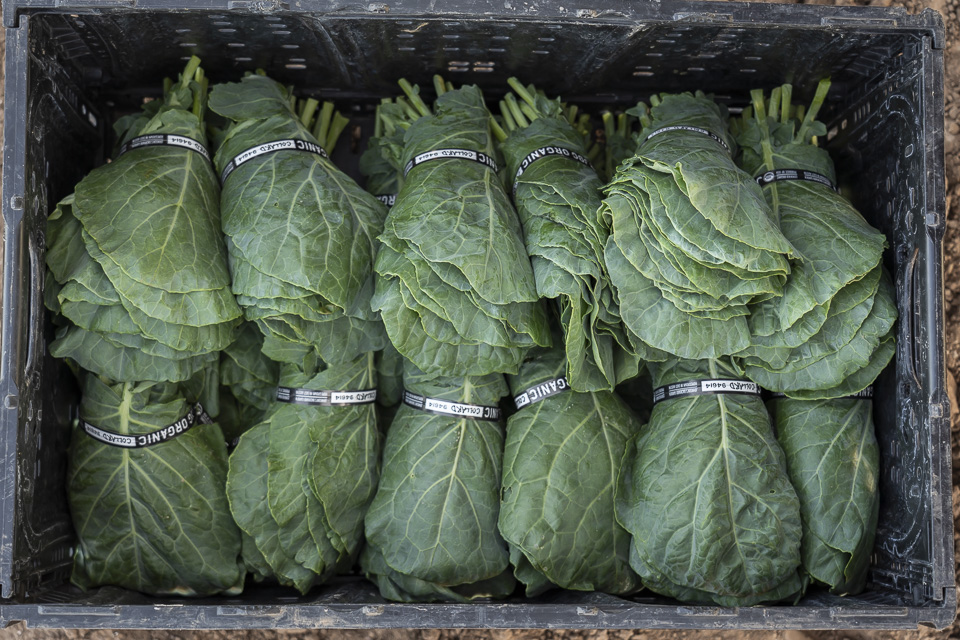 It's been a long time since we've harvested full bins of collards! Let the fun begin! Photo by Scott David Gordon.
It's been a long time since we've harvested full bins of collards! Let the fun begin! Photo by Scott David Gordon.
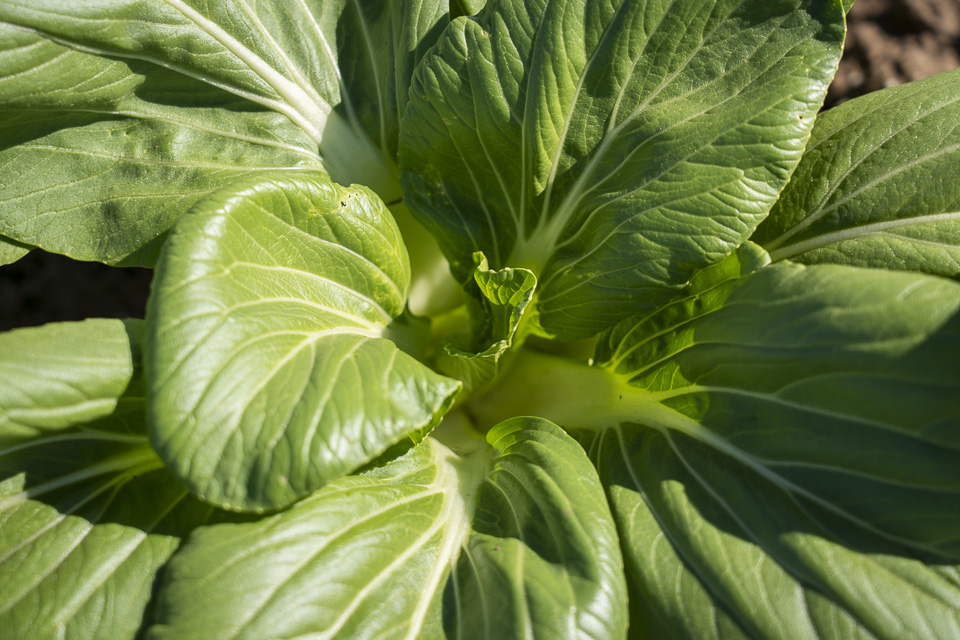 Bok choy leaves looking divine. Photo by Scott David Gordon.
Bok choy leaves looking divine. Photo by Scott David Gordon.





 0 ITEMS IN CART
0 ITEMS IN CART 

